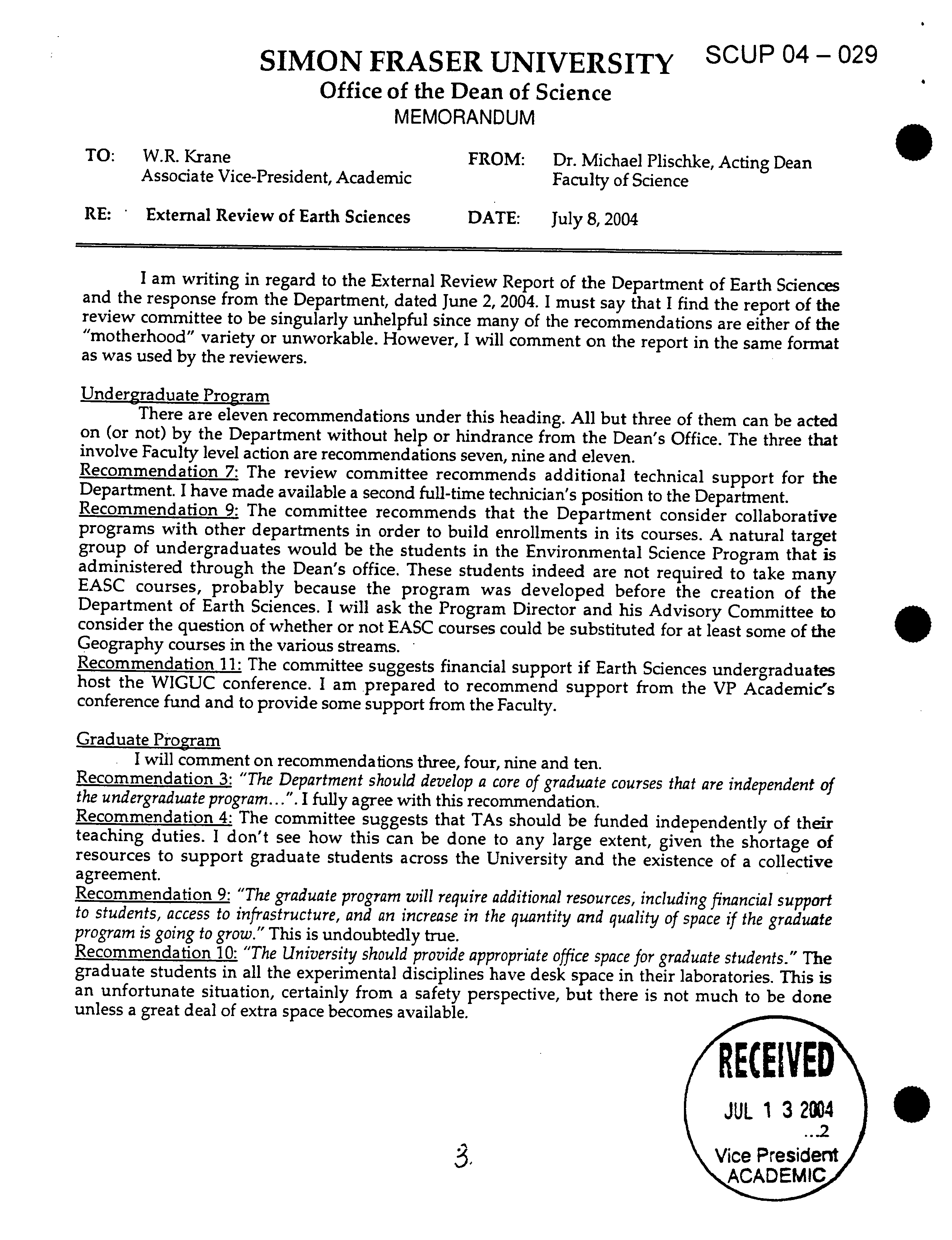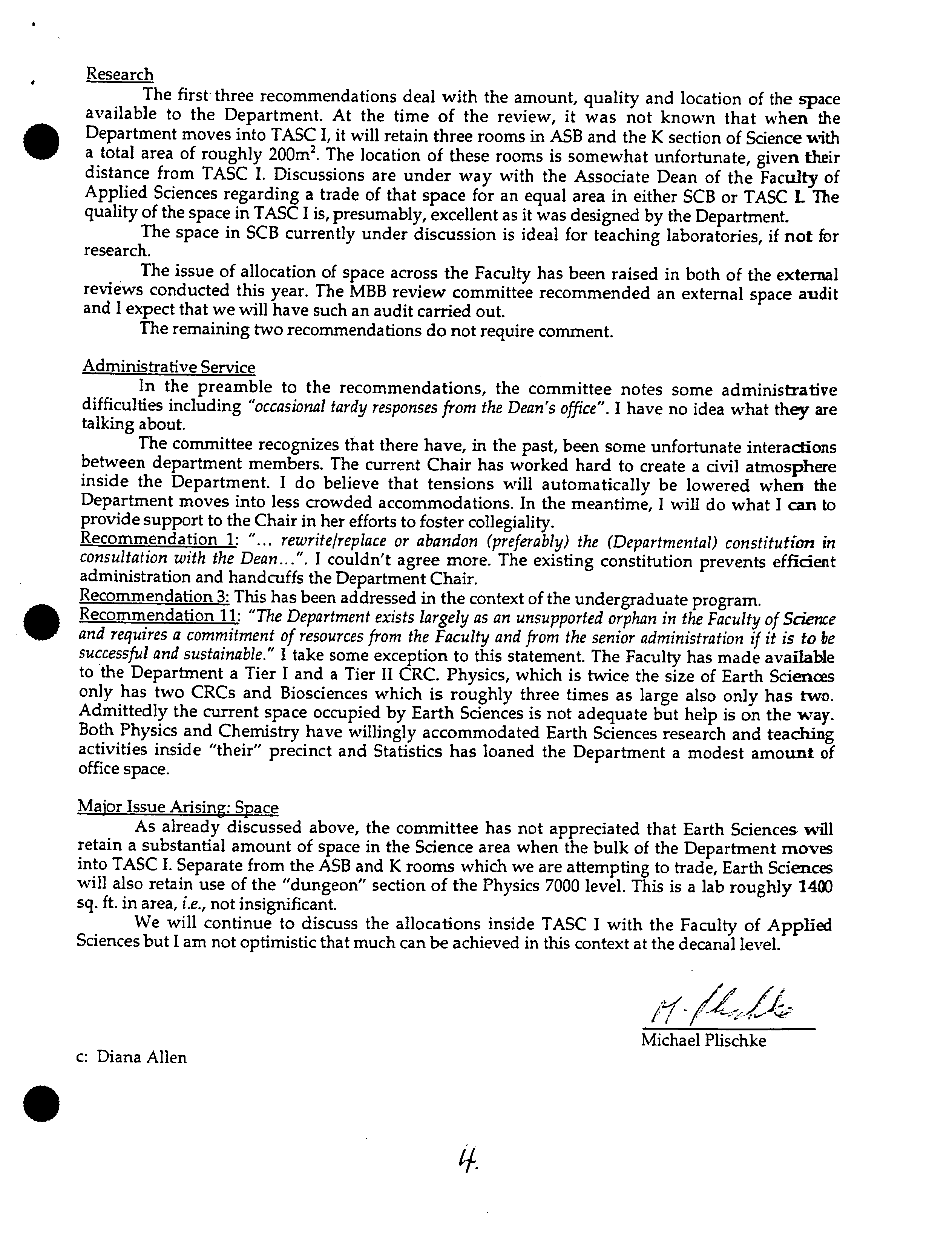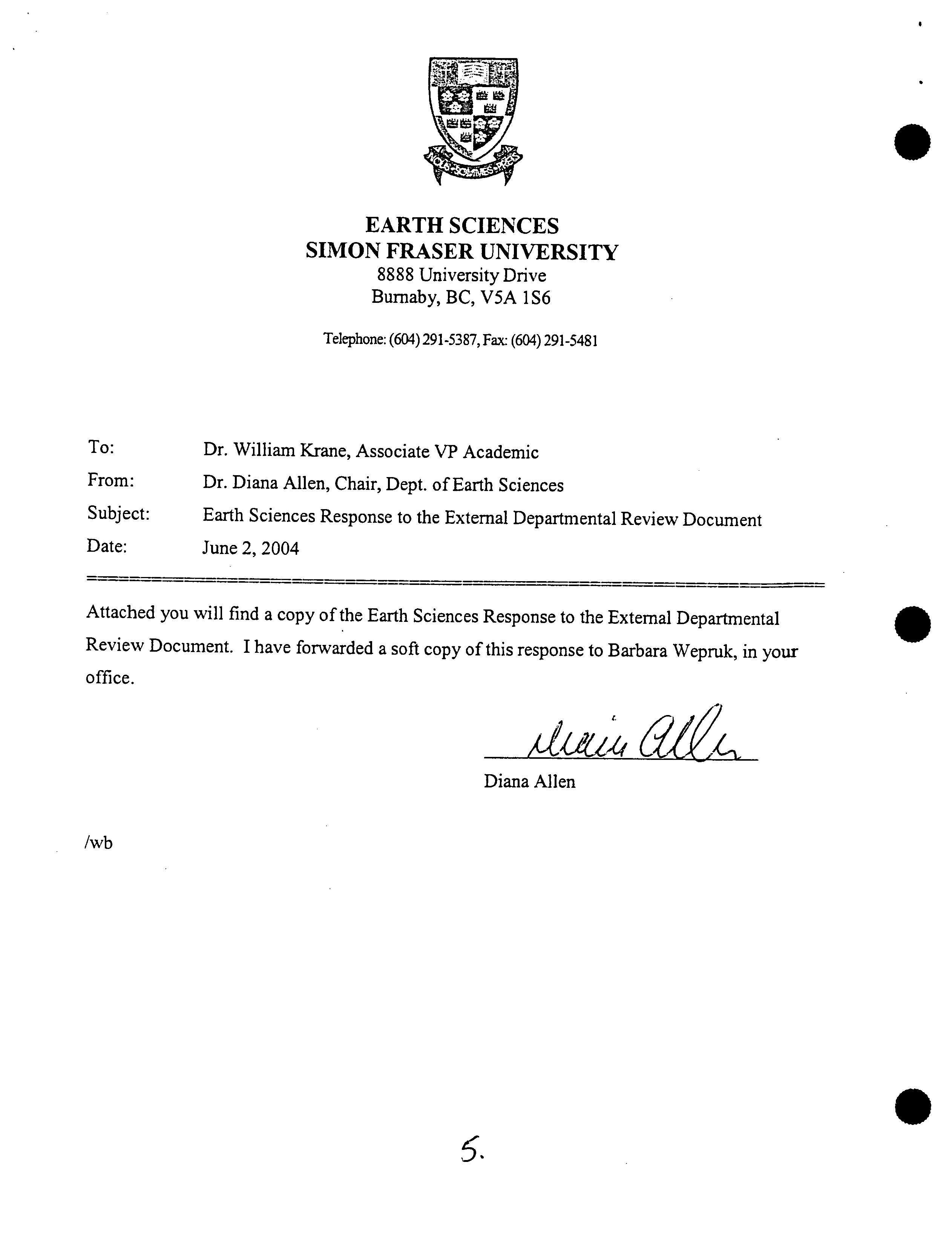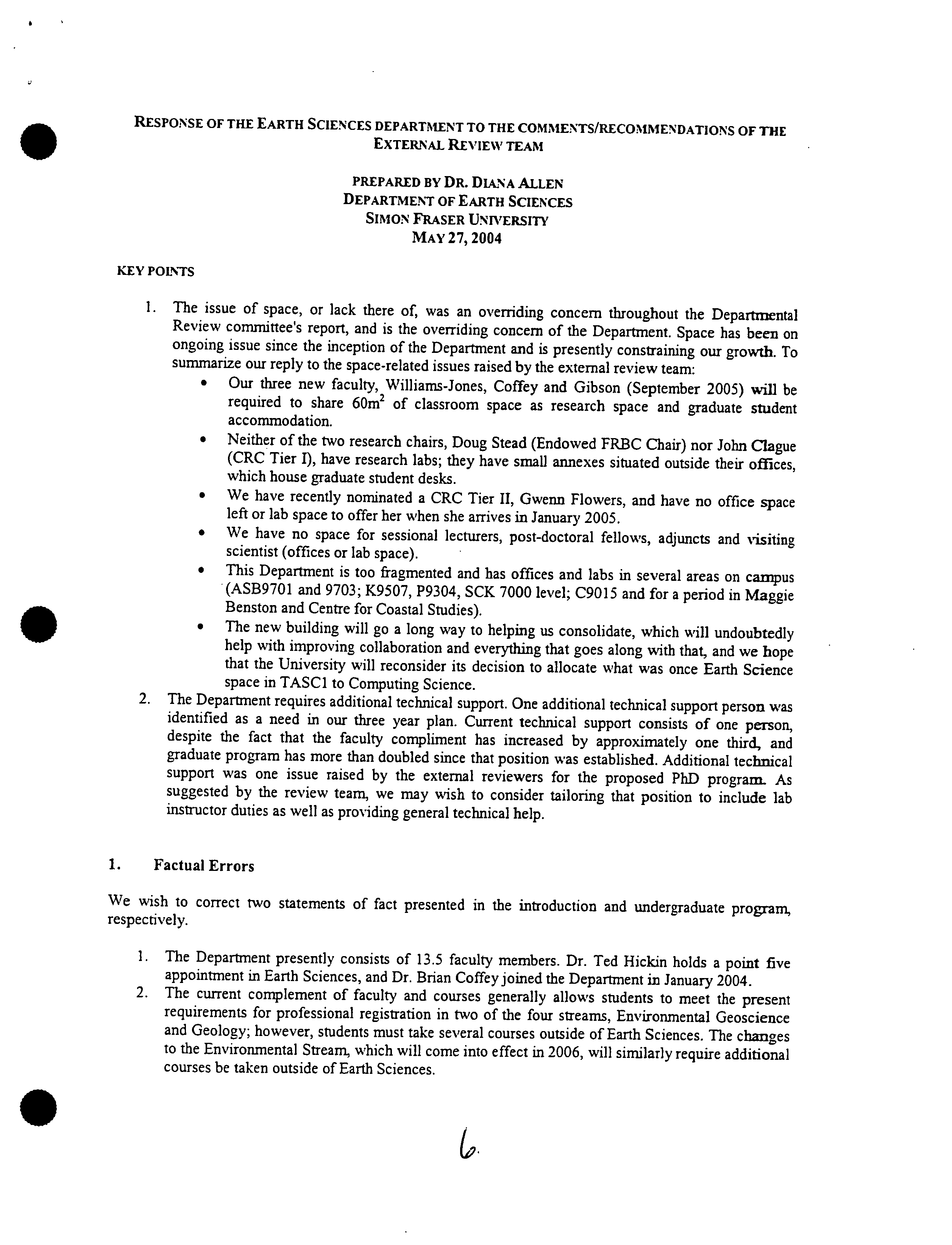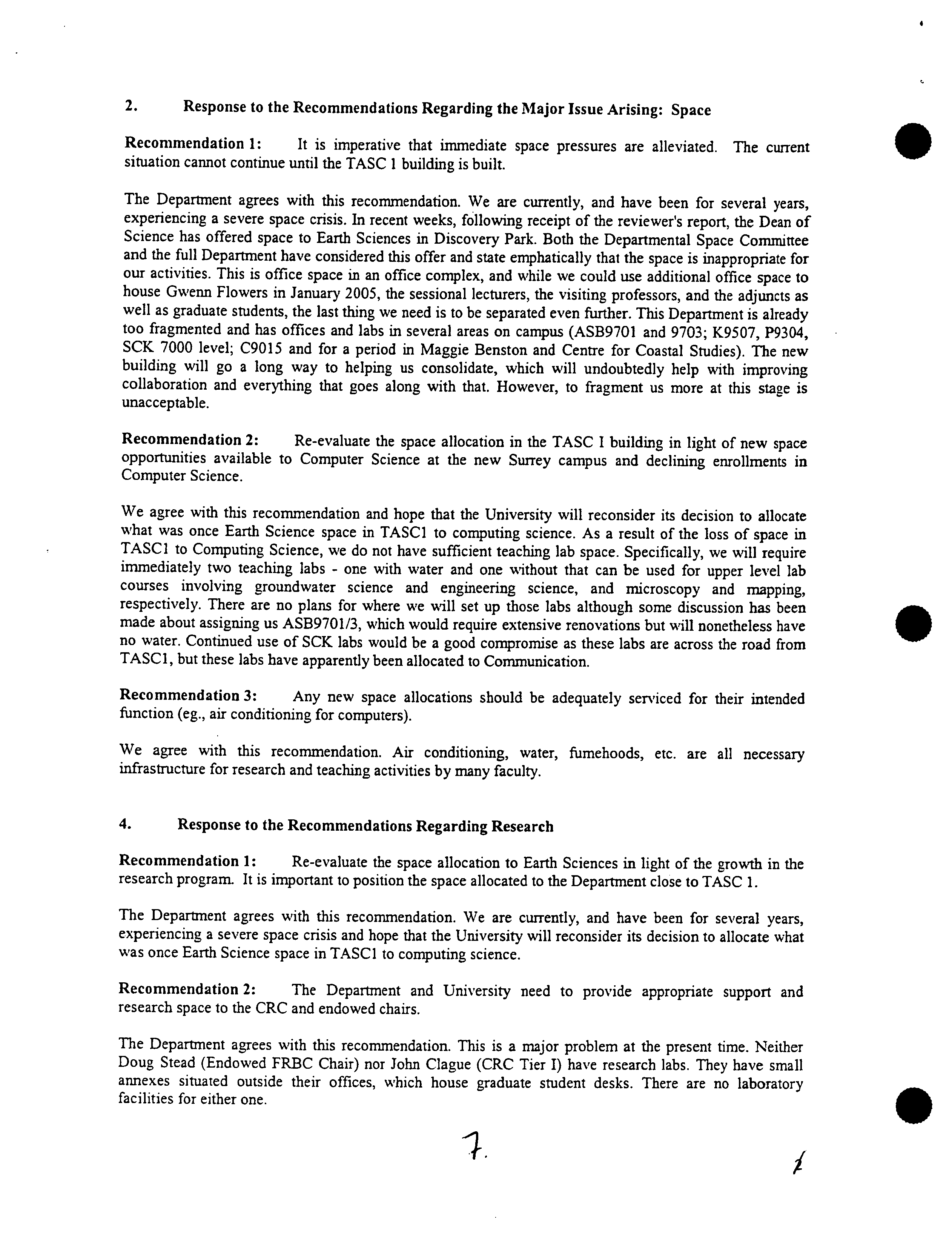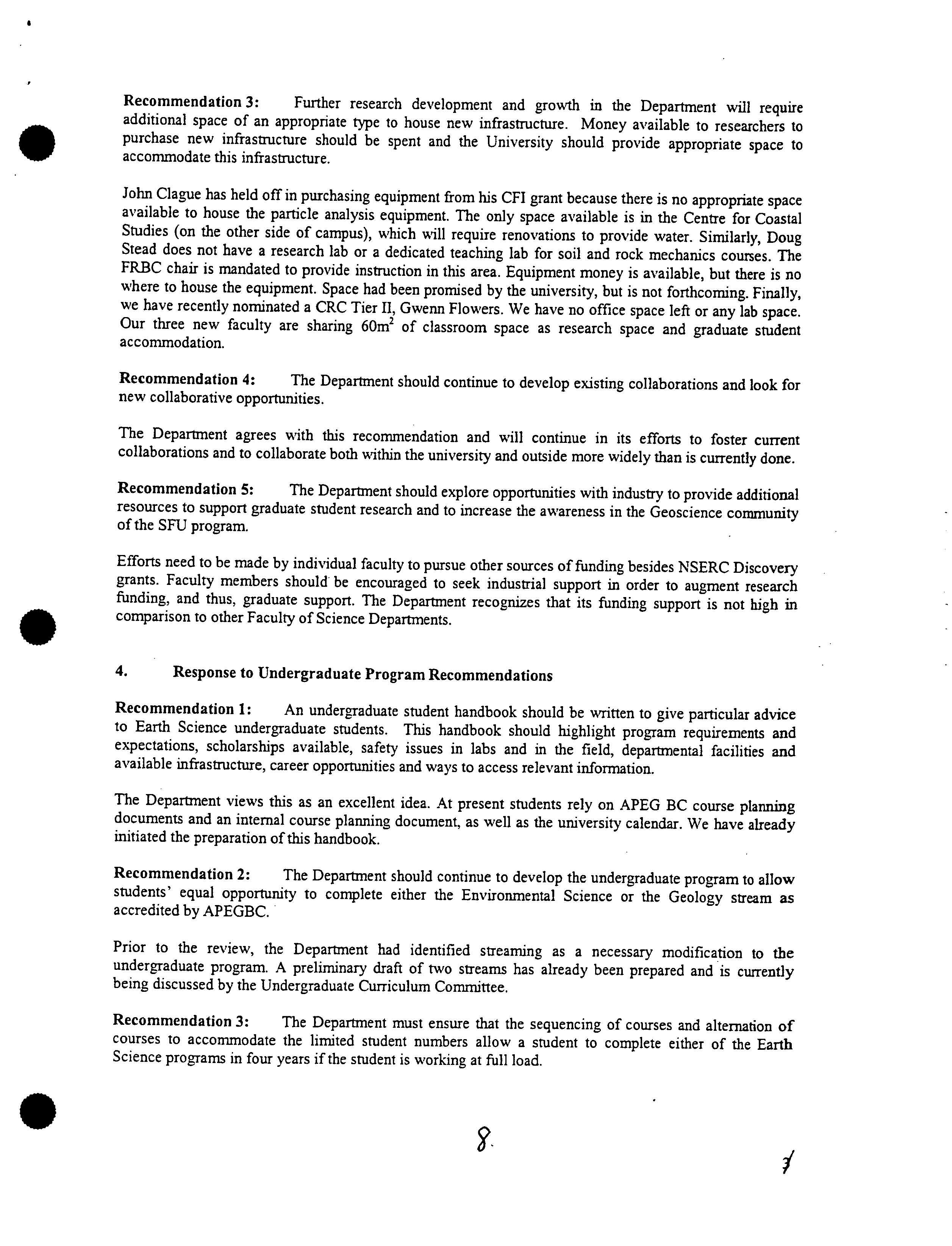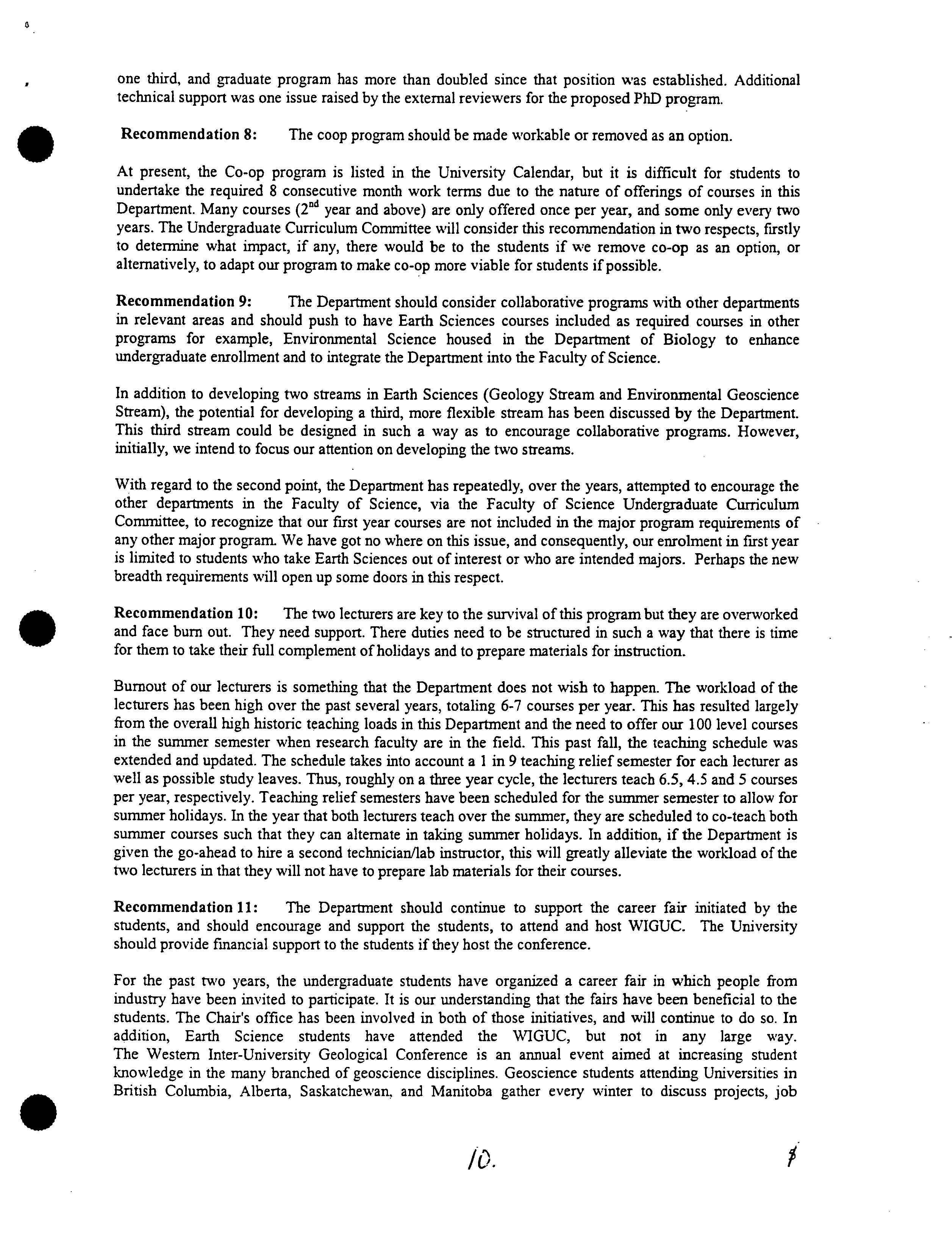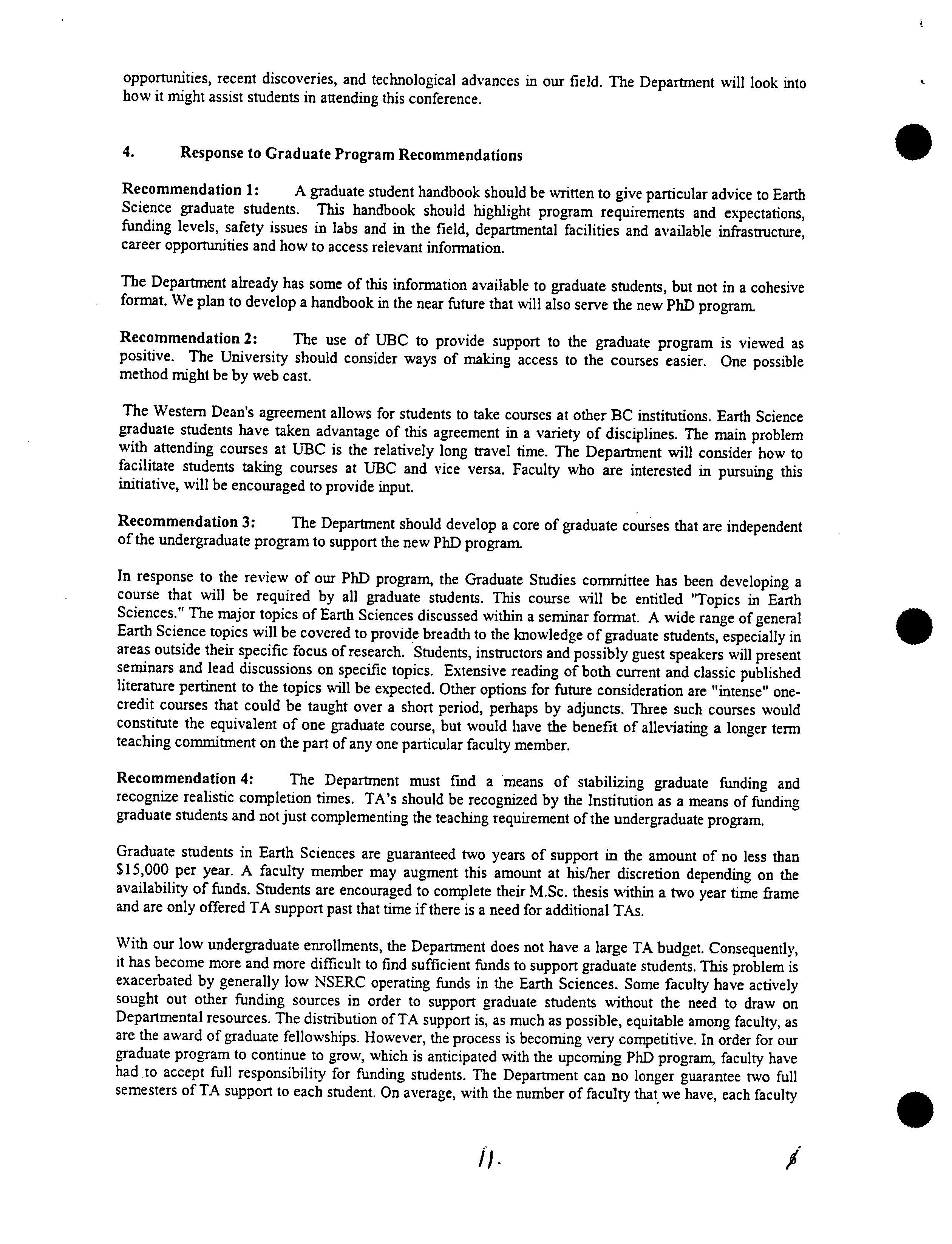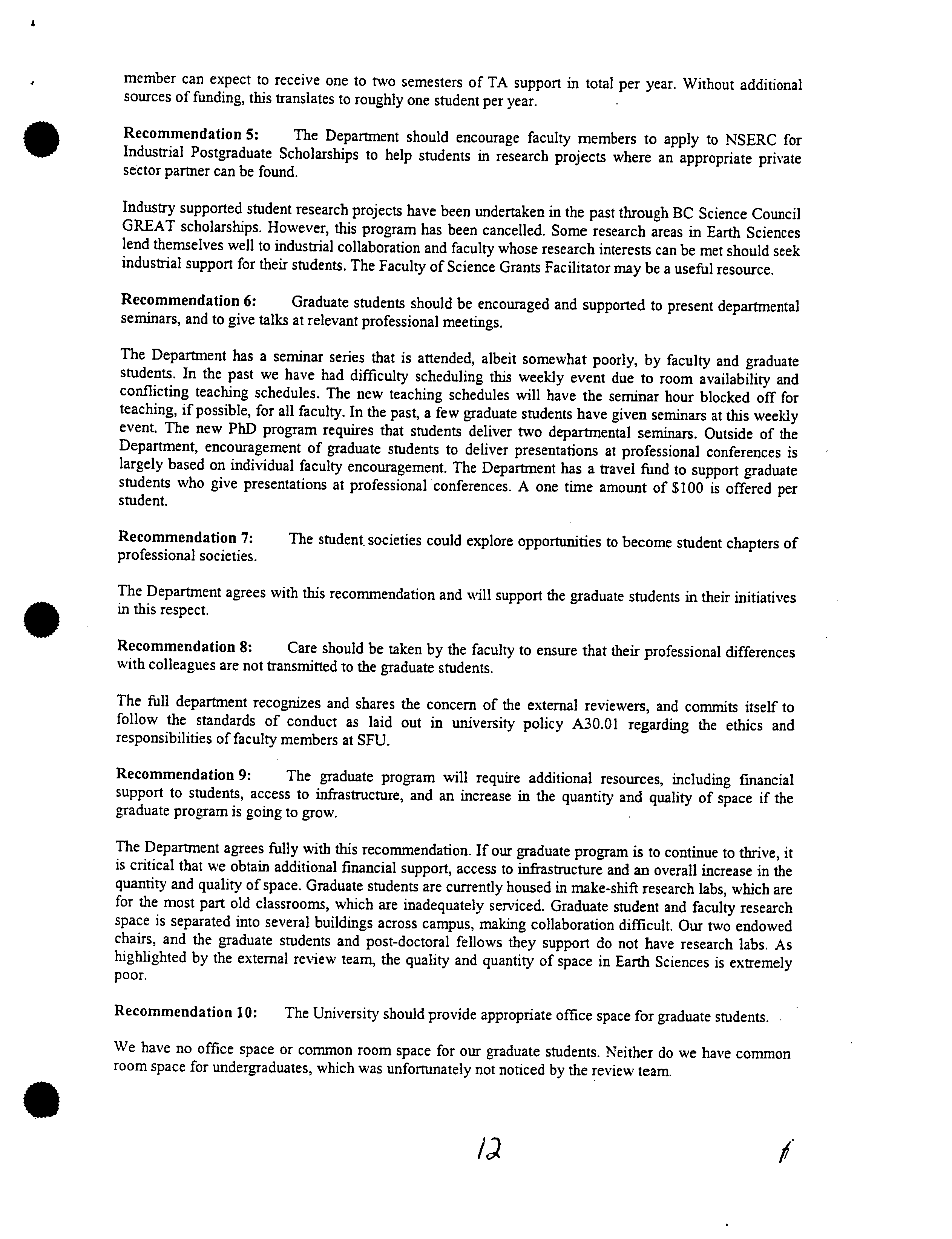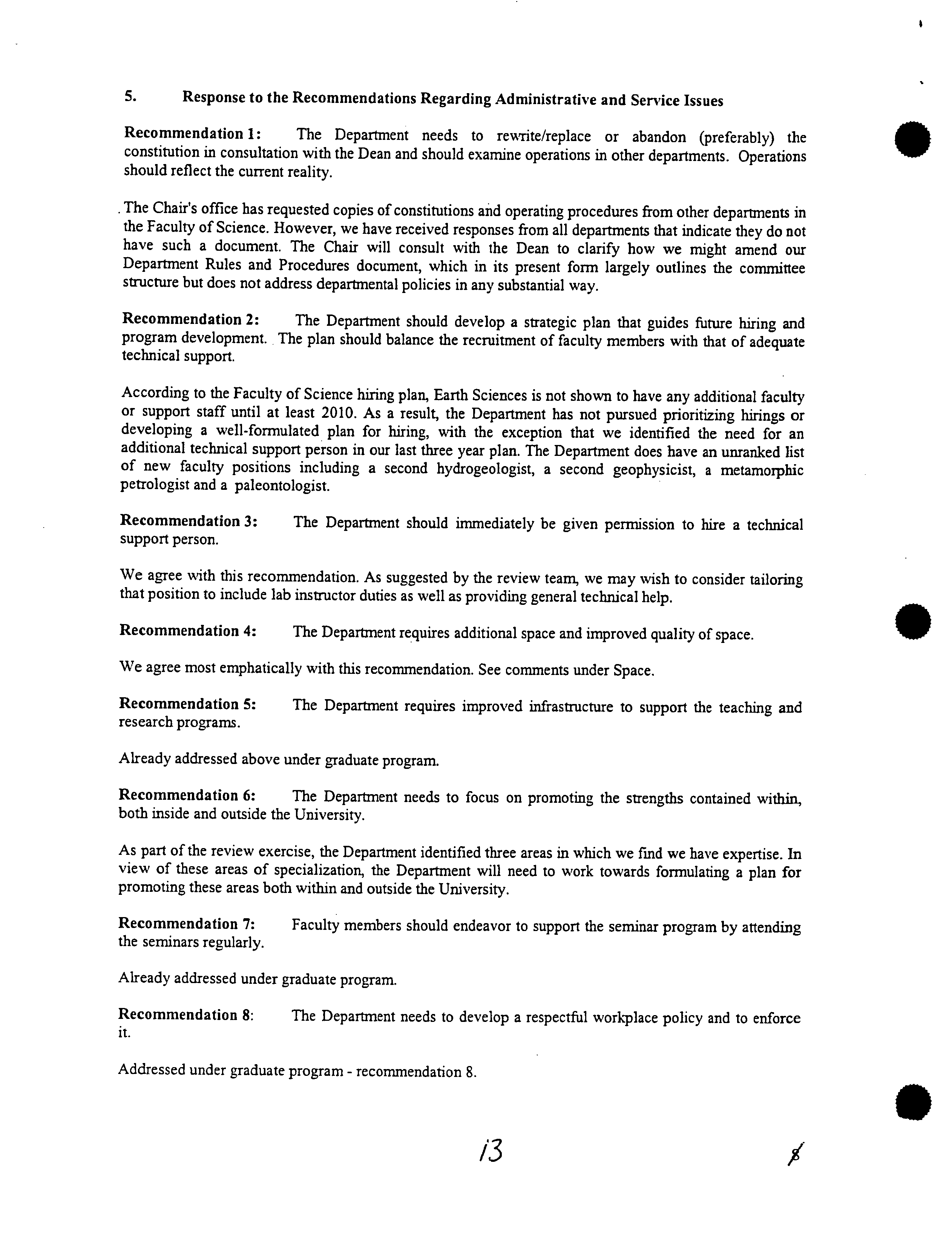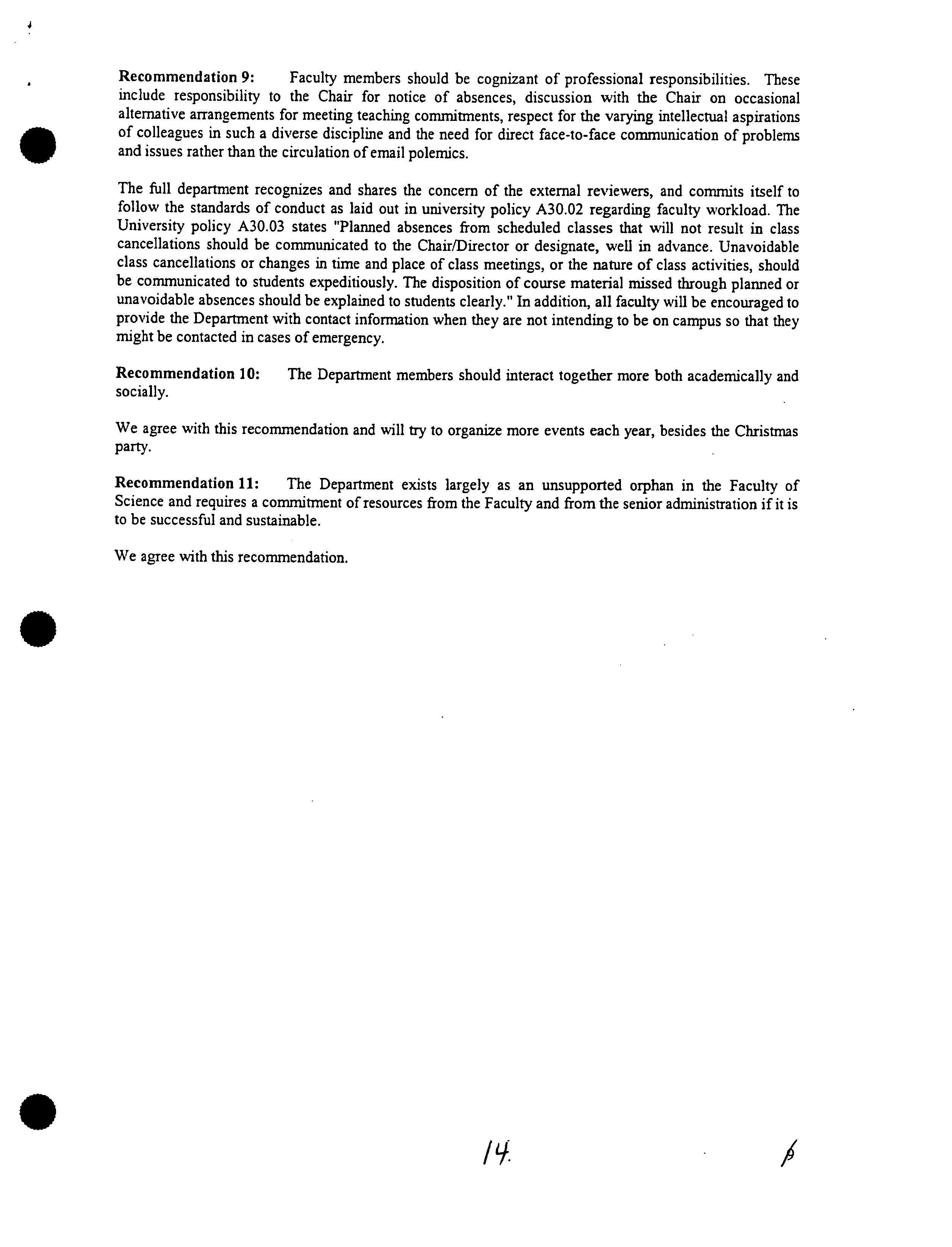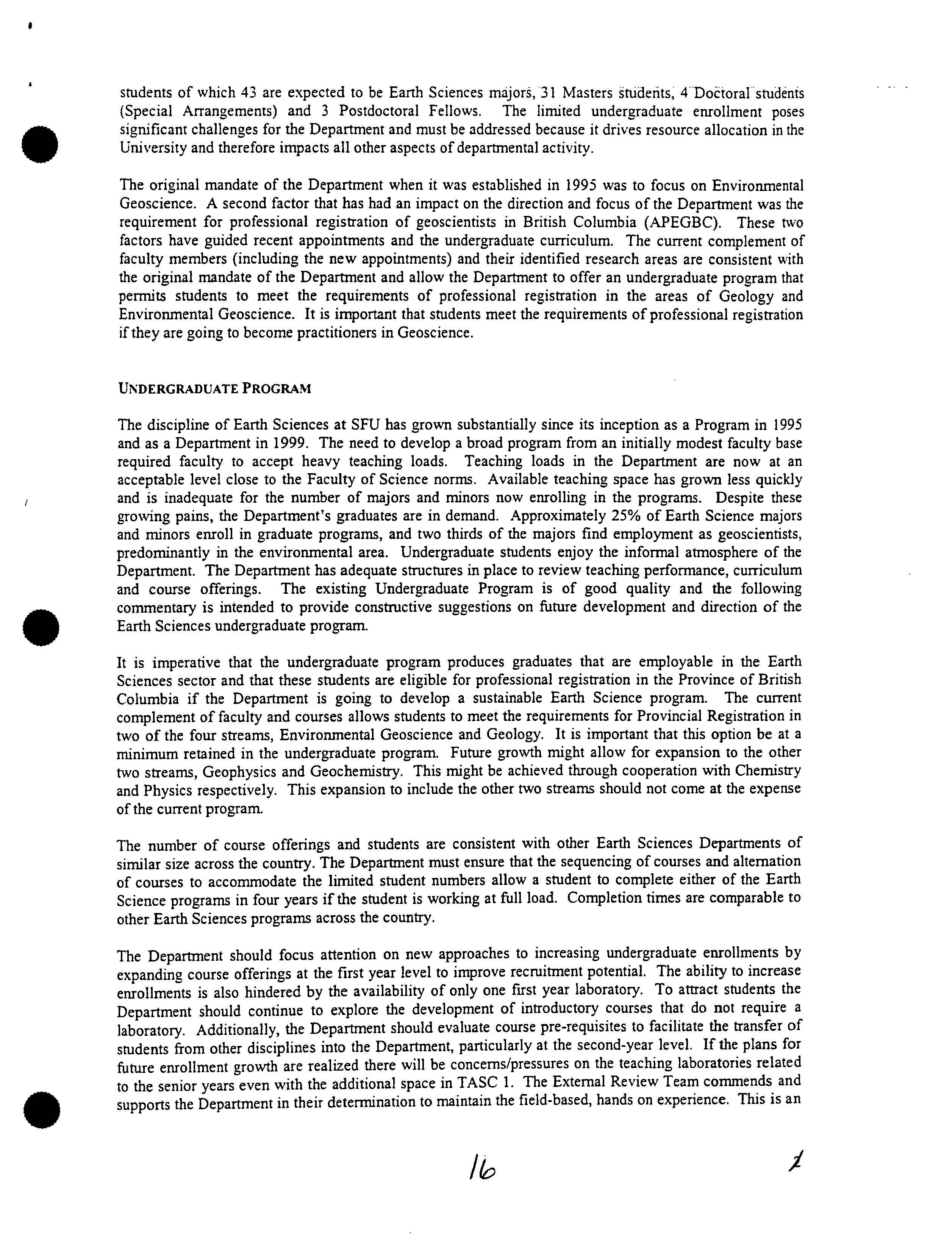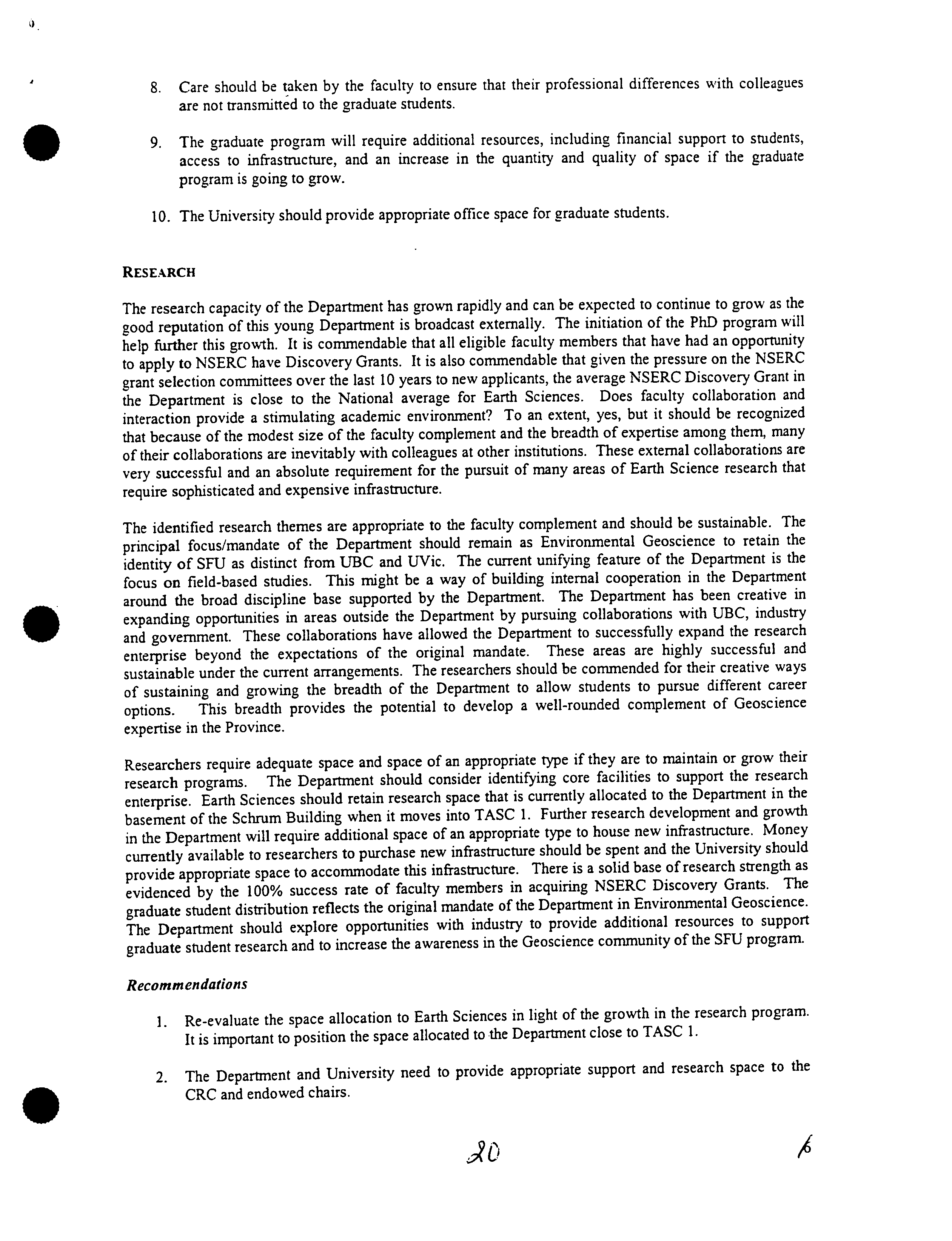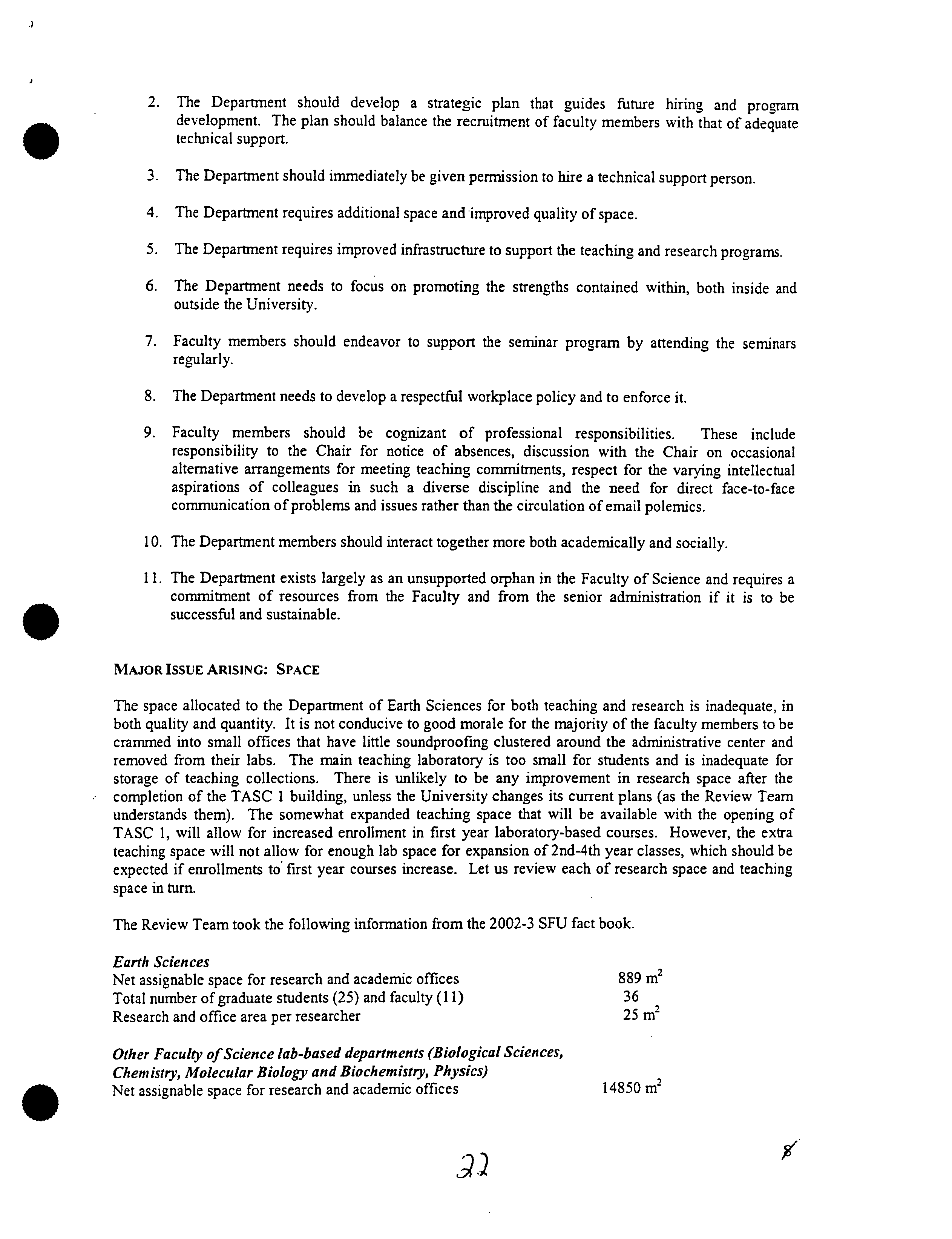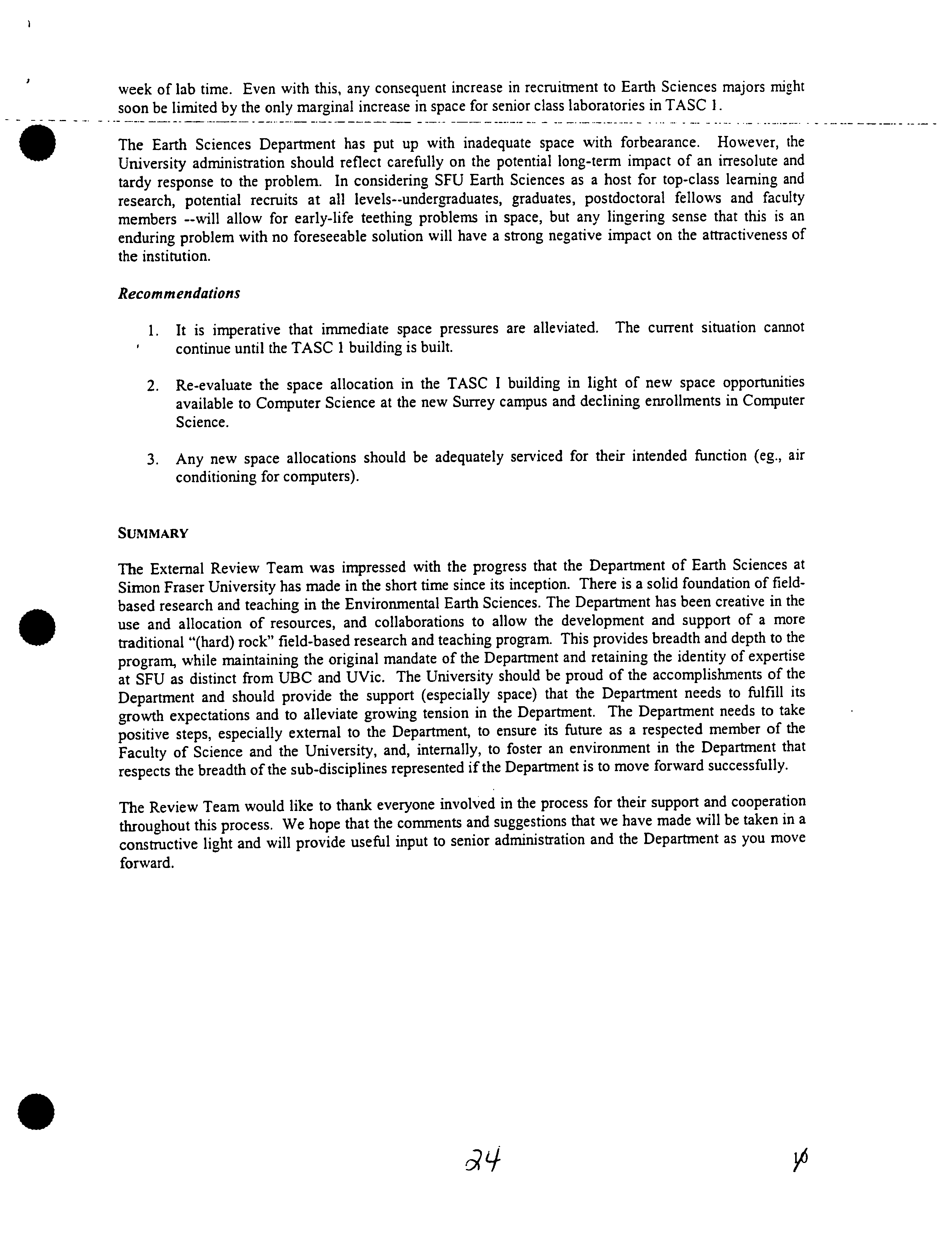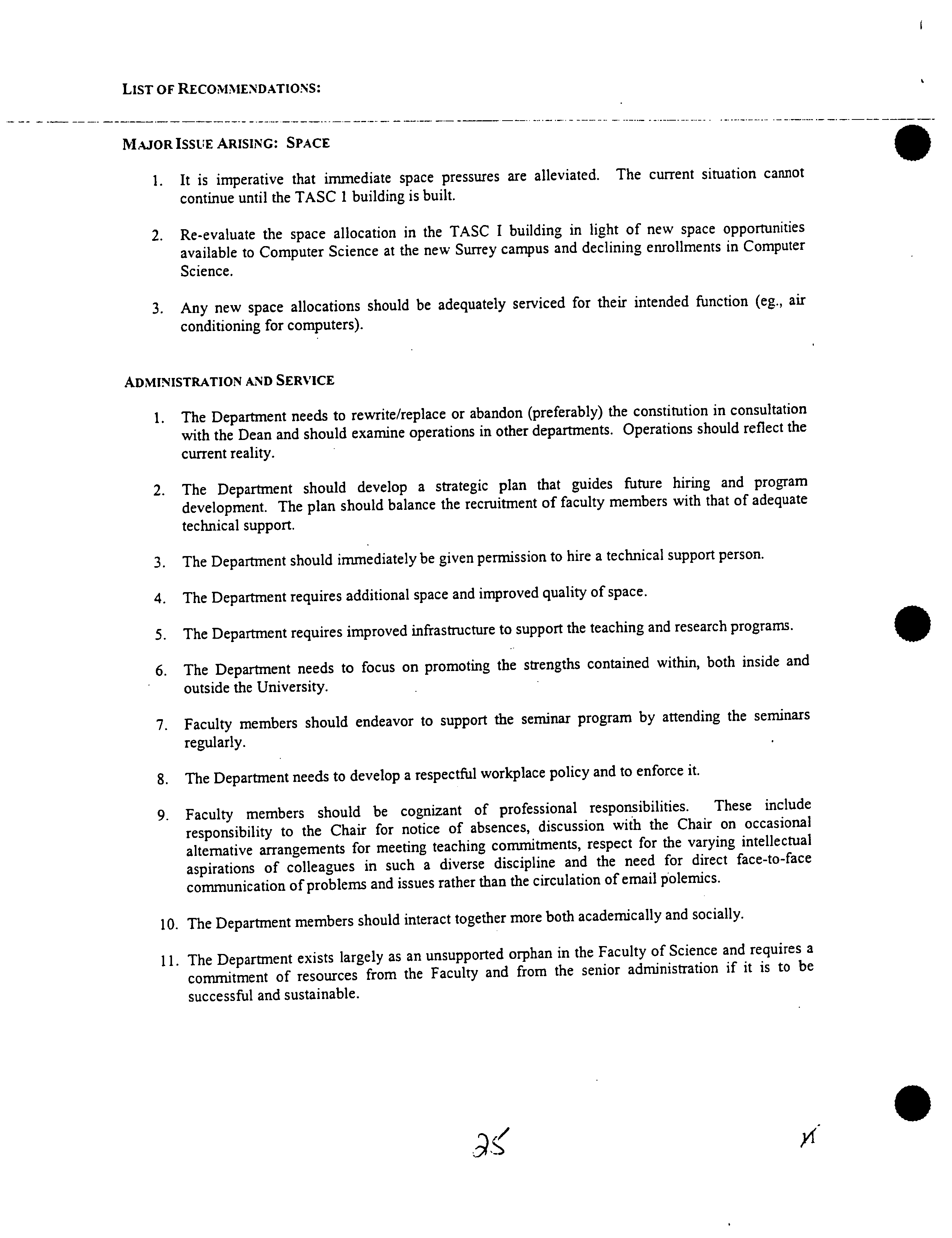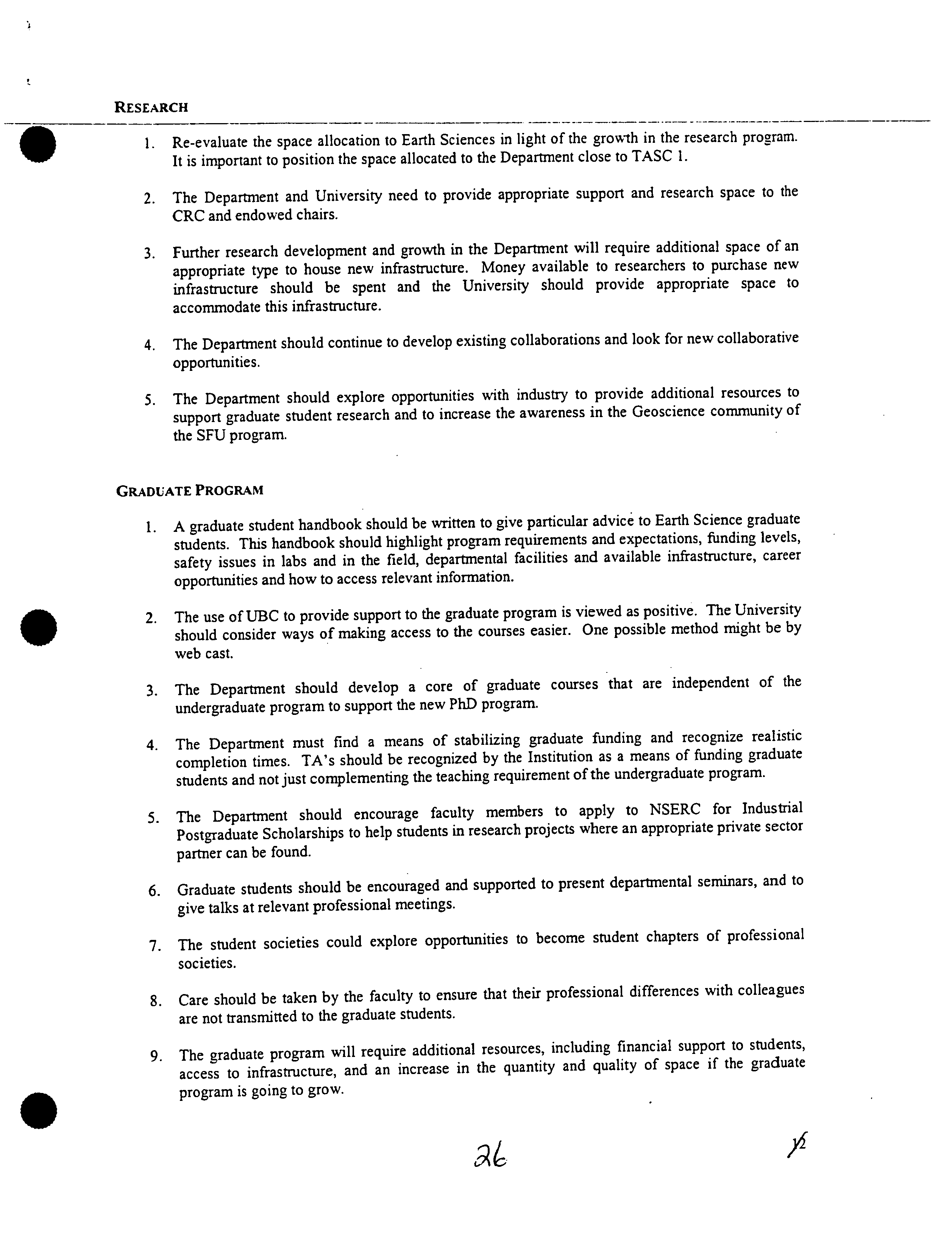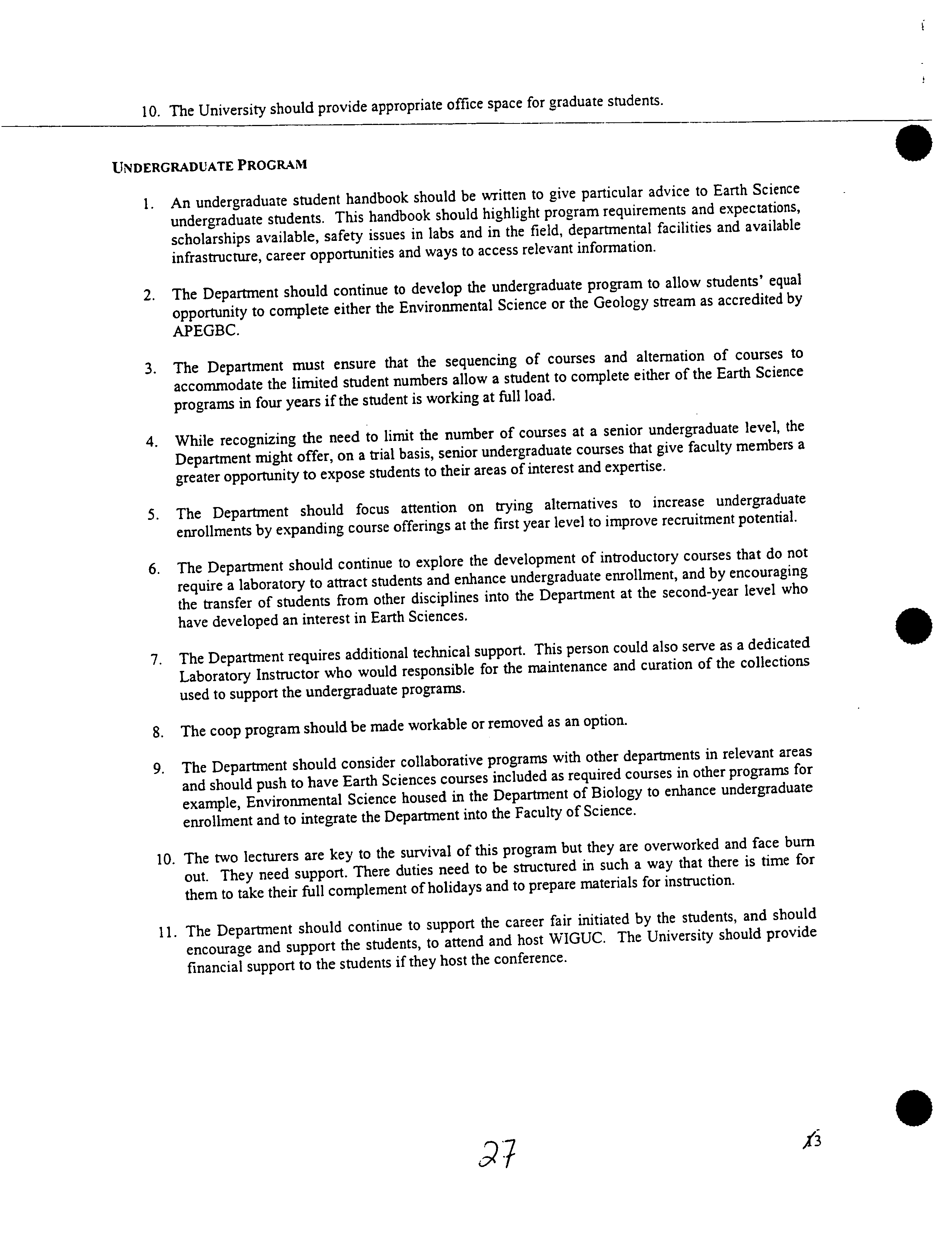:i
e
• ?
SIMON FRASER UNIVERSITY
Senate Committee on University Priorities
?
Memorandum
TO:
Senate
?
FROM:
John Waterhow,
Chair, SCUP
Vice President,
RE:
Department of Earth Sciences ?
DATE: October 6, 2004
External Review
The Senate Committee on University Priorities (SCUP) has reviewed the
External Review Report on the Department of Earth Sciences, together with a
response from the Department of Earth Sciences, the Dean of Science and input
from the Associate Vice-President, Academic.
Motion:
• ?
That Senate concurs with the recommendations from the Senate
Committee on University Priorities concerning advice to the Department of
Earth Sciences on priority items resulting from the external review as
outlined in
S.04-80
The report of the External Review Committee for the Department of Earth
Sciences was submitted on April 19, 2004 following the review site visit which
took place March 24 - 26, 2004. The response of the Department Chair was
received on June 2, 2004 followed by that of the Dean of Science on July 9,
2004.
SCUP recommends to Senate that the Department of Earth Sciences and the
Dean of Science be advised to pursue the following as priority items:
1. Space
1.1 SCUP, the Dean of Science and the Associate Vice-President, Academic
recognize the importance of providing adequate space to the department
and agree to work with the department to resolve this issue.
0
9 ?
2. ?
Undergraduate Program
2.1
?
?
SCUP recommends that the Department develop an undergraduate
student handbook to inform students of program requirements,
scholarships, safety issues, facilities available and career opportunities.
2.2 SCUP recommends that the Department increase the technical support for
students in the form of a Technician, and is grateful to the Dean for
providing the required funding for this.
2.3 SCUP recommends that the Faculty of Science consider having Earth
Science courses included as required courses in other programs.
3.
Graduate Program
3.1 SCUP recommends that the Department develop a graduate student
handbook to inform students of program requirements, scholarships,
safety issues, facilities available and career opportunities.
3.2 SCUP recommends that the Department develop a core of graduate
courses independent of the undergraduate program to support the new
PhD program.
3.3
?
SCUP recommends that before expanding the graduate program, financial
and other resources need to be reviewed for their adequacy by the
Department and the Faculty of Science.
4.
Administration
4.1 ?
SCUP recommends that the Department revise its constitution in
consultation with the Dean of Science.
4.2 SCUP recommends that the Department undertake a Strategic Planning
process within the Department which would improve team spirit, increase
understanding and improve the alignment of issues and priorities.
0
KI
SIMON FRASER UNIVERSITY SOUP 04-029
Office of the Dean of Science
MEMORANDUM
TO: W.R. Krane
?
FROM: Dr. Michael Plischke, Acting Dean
Associate Vice-President, Academic
?
Faculty of Science
RE: ?
External Review of
Earth Sciences ?
DATE: ?
July 8, 2004
I am writing in regard to the External Review Report of the Department of Earth Sciences
and the response from the Department, dated June 2, 2004. I must say that I find the report of the
review committee to be singularly unhelpful since many of the recommendations are either of the
"motherhood" variety or unworkable. However, I will comment on the report in the same format
as was used by the reviewers.
Undergraduate Program
There are eleven recommendations under this heading. All but three of them can be acted
on (or not) by the Department without help or hindrance from the Dean's Office. The three that
involve Faculty level action are recommendations seven, nine and eleven.
Recommendation 7: The review committee recommends additional technical support for the
Department. I have made available a second full-time technician's position to the Department.
Recommendation 9: The committee recommends that the Department consider collaborative
programs with other departments in order to build enrollments in its courses. A natural target
group of undergraduates would be the students in the Environmental Science Program that is
administered through the Dean's office. These students indeed are not required to take many
EASC courses, probably because the program was developed before the creation of the
Department of Earth Sciences. I will ask the Program Director and his Advisory Committee to
consider the question of whether or not EASC courses could be substituted for at least some of the
Geography courses in the various streams.
Recommendation 11: The committee suggests financial support if Earth Sciences undergraduates
host the WIGUC conference. I am prepared to recommend support from the VP Academic's
conference fund and to provide some support from the Faculty.
Graduate Program
I will comment on recommendations three, four, nine and ten.
Recommendation
3:
"The Department should develop a core of graduate courses that are independent
of
the undergraduate program...". I
fully agree with this recommendation.
Recommendation 4: The committee suggests that TAs should be funded independently of their
teaching duties. I don't see how this can be done to any large extent, given the shortage of
resources to support graduate students across the University and the existence of a collective
agreement.
Recommendation 9: "The graduate program will require additional resources, including financial support
to students, access to infrastructure, and an increase in the quantity and quality of space
if
the graduate
program is going to grow."
This is undoubtedly true.
Recommendation 10:
"The University should provide appropriate office space for graduate students."
The
graduate students in all the experimental disciplines have desk space in their laboratories. This is
an unfortunate situation, certainly from a safety perspective, but there is not much to be done
unless a great deal of extra space becomes available.
RJ0L132004
?
•
\ice
nCADEM1C_,o
President
Research
The first three recommendations deal with the amount, quality and location of the space
available to the Department. At the time of the review, it was not known that when the
S
Department moves into TASC I, it will retain three rooms in ASB and the K section of Science with
a total area of roughly 200m
2
. The location of these rooms is somewhat unfortunate, given their
distance from TASC I. Discussions are under way with the Associate Dean of the Faculty of
Applied Sciences regarding a trade of that space for an equal area in either SCB or TASC L The
quality of the space in TASC I is, presumably, excellent as it was designed by the Department.
The space in SCB currently under discussion is ideal for teaching laboratories, if
not
for
research.
The issue of allocation of space across the Faculty has been raised in both of the external
reviews conducted this year. The MBB review committee recommended an external space audit
and I expect that we will have such an audit carried out.
The remaining two recommendations do not require comment.
Administrative Service
In the preamble to the recommendations, the committee notes some administrative
difficulties including "occasional tardy responses from the Dean's office". I
have no idea what they are
talking about.
The committee recognizes that there have, in the past, been some unfortunate interactions
between department members. The current Chair has worked hard to create a civil atmosphere
inside the Department. I do believe that tensions will automatically be lowered when the
Department moves into less crowded accommodations. In the meantime, I will do what I can to
provide support to the Chair in her efforts to foster collegiality.
Recommendation 1: "... rewrite/replace or abandon (preferably) the (Departmental) constitution in
consultation with the Dean...". I
couldn't agree more. The existing constitution prevents efficient
administration and handcuffs the Department Chair.
Recommendation 3: This has been addressed in the context of the undergraduate program.
S
Recommendation 11:
"The Department exists largely as an unsupported orphan in the Faculty of Science
and requires a commitment of resources from the Faculty and from the senior administration if it is to be
successful and sustainable." I
take some exception to this statement. The Faculty has made available
to the Department a Tier I and a Tier II CRC. Physics, which is twice the size of Earth Sciences
only has two CRCs and Biosciences which is roughly three times as large also only has two.
Admittedly the current space occupied by Earth Sciences is not adequate but help is on the way.
Both Physics and Chemistry have willingly accommodated Earth Sciences research and teaching
activities inside "their" precinct and Statistics has loaned the Department a modest amount of
office space.
Major Issue Arising: Space
As already discussed above, the committee has not appreciated that Earth Sciences will
retain a substantial amount of space in the Science area when the bulk of the Department moves
into TASC I. Separate from the ASB and K rooms which we are attempting to trade, Earth Sciences
will also retain use of the "dungeon" section of the Physics 7000 level. This is a lab roughly 1400
sq. ft. in area, i.e., not insignificant.
We will continue to discuss the allocations inside TASC I with the Faculty of Applied
Sciences but I am not optimistic that much can be achieved in this context at the decanal level.
Michael Plischke
c: Diana Allen
.
'it.
EARTH SCIENCES
SIMON FRASER UNIVERSITY
?
8888 University Drive
?
Burnaby, BC, V5A 1S6
Telephone: (604) 291-5387, Fax: (604) 291-5481
To:
?
Dr. William Krane, Associate VP Academic
From: ?
Dr. Diana Allen, Chair, Dept. of Earth Sciences
Subject: ?
Earth Sciences Response to the External Departmental Review Document
Date: ?
June 2, 2004
Attached you will find a copy of the Earth Sciences Response to the External Departmental
Review Document. I have forwarded a soft copy of this response to Barbara Wepruk, in your
office.
Diana Allen
/wb
0
. ?
RESPONSE OF THE EARTH SCIENCES DEPARTMENT TO THE COMMENTS/RECOMMENDATIONS OF THE
EXTERNAL REVIEW TEAM
PREPARED BY DR. DIANA ALLEN
DEPARTMENT OF EARTH SCIENCES
SIMoN FRASER UNIVERSITY
MAY 27, 2004
KEY POINTS
1.
The issue of space, or lack there of, was an overriding concern throughout the Departmental
Review committee's report, and is the overriding concern of the Department. Space has been on
ongoing issue since the inception of the Department and is presently constraining our growth. To
summarize our reply to the space-related issues raised by the external review team:
• Our three new faculty, Williams-Jones, Coffey and Gibson (September 2005) will be
required to share 60m
2
of classroom space as research space and graduate student
accommodation.
• Neither of the two research chairs, Doug Stead (Endowed FR.BC Chair) nor John Clague
(CRC Tier I), have research labs; they have small annexes situated outside their offices,
which house graduate student desks.
• We have recently nominated a CRC Tier II, Gwenn Flowers, and have no office space
left or lab space to offer her when she arrives in January 2005.
• We have no space for sessional lecturers, post-doctoral fellows, adjuncts and visiting
scientist (offices or lab space).
• This Department is too fragmented and has offices and labs in several areas on campus
(ASB9701 and 9703; K9507, P9304, SCK 7000 level; C9015 and for a period in Maggie
•
?
Benston and Centre for Coastal Studies).
• The new building will go a long way to helping us consolidate, which will undoubtedly
help with improving collaboration and everything that goes along with that, and we hope
that the University will reconsider its decision to allocate what was once Earth Science
space in TASC1 to Computing Science.
2.
The Department requires additional technical support. One additional technical support person was
identified as a need in our three year plan. Current technical support consists of one person,
despite the fact that the faculty compliment has increased by approximately one third, and
graduate program has more than doubled since that position was established. Additional technical
support was one issue raised by the external reviewers for the proposed PhD program. As
suggested by the review team, we may wish to consider tailoring that position to include lab
instructor duties as well as providing general technical help.
1. ?
Factual Errors
We wish to correct two statements of fact presented in the introduction and undergraduate program,
respectively.
The Department presently consists of 13.5 faculty members. Dr. Ted Hickin holds a point five
appointment in Earth Sciences, and Dr. Brian Coffey joined the Department in January
2004.
The current complement of faculty and courses generally allows students to meet the present
requirements for professional registration in two of the four streams, Environmental Geoscience
and Geology; however, students must take several courses outside of Earth Sciences. The changes
to the Environmental Stream, which will come into effect in 2006, will similarly require additional
courses be taken outside of Earth Sciences.
.
L.
2.
?
Response to the Recommendations Regarding the Major Issue Arising: Space
Recommendation 1:
?
It is imperative that immediate space pressures are alleviated. The current
situation cannot continue until the TASC 1 building is built.
The Department agrees with this recommendation. We are currently, and have been for several years,
experiencing a severe space crisis. In recent weeks, following receipt of the reviewers report, the Dean of
Science has offered space to Earth Sciences in Discovery Park. Both the Departmental Space Committee
and the full Department have considered this offer and state emphatically that the space is inappropriate for
our activities. This is office space in an office complex, and while we could use additional office space to
house Gwenn Flowers in January 2005, the sessional lecturers, the visiting professors, and the adjuncts as
well as graduate students, the last thing we need is to be separated even further. This Department is already
too fragmented and has offices and labs in several areas on campus (ASB970I and 9703; K9507, P9304,
SCK 7000 level; C9015 and for a period in Maggie Benston and Centre for Coastal Studies). The new
building will go a long way to helping us consolidate, which will undoubtedly help with improving
collaboration and everything that goes along with that. However, to fragment us more at this stage is
unacceptable.
Recommendation 2: Re-evaluate the space allocation in the TASC I building in light of new space
opportunities available to Computer Science at the new Surrey campus and declining enrollments in
Computer Science.
We agree with this recommendation and hope that the University will reconsider its decision to allocate
what was once Earth Science space in TASCI to computing science. As a result of the loss of space in
TASC1 to Computing Science, we do not have sufficient teaching lab space. Specifically, we will require
immediately two teaching labs - one with water and one without that can be used for upper level lab
courses involving groundwater science and engineering science, and microscopy and mapping,
respectively. There are no plans for where we will set up those labs although some discussion has been
made about assigning us ASB9701/3, which would require extensive renovations but will nonetheless have
no water. Continued use of SCK labs would be a good compromise as these labs are across the road from
TASC I, but these labs have apparently been allocated to Communication.
Recommendation
3:
?
Any new space allocations should be adequately serviced for their intended
function (eg., air conditioning for computers).
We agree with this recommendation. Air conditioning, water, fumehoods, etc. are all necessary
infrastructure for research and teaching activities by many faculty.
4.
?
Response to the Recommendations Regarding Research
Recommendation 1:
?
Re-evaluate the space allocation to Earth Sciences in light of the growth in the
research program. It is important to position the space allocated to the Department close to TASC 1.
The Department agrees with this recommendation. We are currently, and have been for several years,
experiencing a severe space crisis and hope that the University will reconsider its decision to allocate what
was once Earth Science space in TASC1 to computing science.
Recommendation 2:
?
The Department and University need to provide appropriate support and
research space to the CRC and endowed chairs.
The Department agrees with this recommendation. This is a major problem at the present time. Neither
Doug Stead (Endowed FRBC Chair) nor John Clague (CRC Tier I) have research labs. They have small
annexes situated outside their offices, which house graduate student desks. There are no laboratory
facilities for either one.
?
0
Recommendation
3: ?
Further research development and growth in the Department will require
?
additional space of an appropriate type to house new infrastructure. Money available to researchers to
.
??
purchase new infrastructure should be spent and the University should provide appropriate space to
?
accommodate this infrastructure.
John Clague has held off in purchasing equipment from his CFI grant because there is no appropriate space
available to house the particle analysis equipment. The only space available is in the Centre for Coastal
Studies (on the other side of campus), which will require renovations to provide water. Similarly, Doug
Stead does not have a research lab or a dedicated teaching lab for soil and rock mechanics courses. The
FRBC chair is mandated to provide instruction in this area. Equipment money is available, but there is no
where to house the equipment. Space had been promised by the university, but is not forthcoming. Finally,
we have recently nominated a CRC Tier 11, Gwenn Flowers. We have no office space left or any lab space.
Our three new faculty are sharing 60m
2
of classroom space as research space and graduate student
accommodation.
Recommendation 4:
?
The Department should continue to develop existing collaborations and look for
?
new collaborative opportunities.
The Department agrees with this recommendation and will continue in its efforts to foster current
collaborations and to collaborate both within the university and outside more widely than is currently done.
Recommendation 5:
The Department should explore opportunities with industry to provide additional
resources to support graduate student research and to increase the awareness in the Geoscience community
of the SFU program.
Efforts need to be made by individual faculty to pursue other sources of funding besides NSERC Discovery
grants. Faculty members should be encouraged to seek industrial support in order to augment research
funding, and thus, graduate support. The Department recognizes that its funding support is not high in
comparison to other Faculty of Science Departments.
4.
?
Response to Undergraduate Program Recommendations
Recommendation 1:
An undergraduate student handbook should be written to give particular advice
to Earth Science undergraduate students. This handbook should highlight program requirements and
expectations, scholarships available, safety issues in labs and in the field, departmental facilities and
available infrastructure, career opportunities and ways to access relevant information.
The Department views this as an excellent idea. At present students rely on APEG BC course planning
documents and an internal course planning document, as well as the university calendar. We have already
initiated the preparation of this handbook.
Recommendation
2: The Department should continue to develop the undergraduate program to allow
students' equal opportunity to complete either the Environmental Science or the Geology stream as
accredited by APEGBC.
Prior to the review, the Department had identified streaming as a necessary modification to the
undergraduate program. A preliminary draft of two streams has already been prepared and is currently
being discussed by the Undergraduate Curriculum Committee.
Recommendation
3: The Department must ensure that the sequencing of courses and alternation of
courses to accommodate the limited student numbers allow a student to complete either of the Earth
Science programs in four years if the student is working at full load.
The sequencing of course offerings has been poorly organized in recent years, largely on account of having
limited instructors (prior to hiring K. Cameron), a bottom-heavy compliment of faculty who were all
eligible for study leave at the same time, the departure of a faculty member, and lack of long-term planning
for course offerings. One of the first activities of the new chair (D. Allen) in September 2003 was to update
the coarse planning and faculty workload spreadsheet and extend it for several years into the future. A three
year teaching schedule (with some room for contingencies) was circulated to the faculty in the early fall of
2003. Course planning now extends several years hence, but will need to be modified slightly to take into
account streaming. The courses at each year are now balanced (same number of courses in fall and spring
semesters) and an attempt has been made to redistribute upper division courses to allow for better
sequencing.
Recommendation 4:
While recognizing the need to limit the number of courses at a senior
undergraduate level, the Department might offer, on a trial basis, senior undergraduate courses that give
faculty members a greater opportunity to expose students to their areas of interest and expertise.
To a large extent this is already being done. In fact, we have a large number of upper division courses
(many more than our lower division offerings), and all faculty currently teach upper division courses (with
the exception of new faculty who have just begun and the two lecturers who generally teach lower division
courses). In fact, it might be said that we have too may upper division courses on the books and not enough
faculty to teach them. Consequently, most of the 3rd and 4
th
year courses that are electives for our majors
(not part of the core program) are taught every second year. In addition, with such limited enrolment,
faculty are encouraged to offer directed readings courses in their area of specialization.
Recommendation
5: The Department should focus attention on trying alternatives to increase
undergraduate enrollments by expanding course offerings at the first year level to improve recruitment
potential.
A major initiative of the Department is to increase lower division enrolment by building up the breadth of
offerings at the first year level. We recognize that boosting first year enrolments is critical to the success of
the Department in all respects. Because Earth Sciences courses are not included in the major requirements
for any other department in the Faculty of Science (or elsewhere), attracting first year students into the
program is very difficult. Nevertheless, we have introduced a first year lab-based Dinosaur course that is
intended to be a breadth and writing intensive course. This fall, we will be offering a new course on
Geohazards (volcanoes, earthquakes, etc.), which will be a lecture only course to target a different student
market, and we are offering a field-based sequel to the Geohazards course in the spring of 2005. In
addition, we have initiated discussion in the Undergraduate Curriculum Committee to shift one of
our
less
subscribed courses (EASC 102) to the second year, and introduce an "Earth System Science course or
"Geology and the Environment" Course that can be taught both at the Burnaby campus and at the new
Surrey campus as part of the first year science offerings.
Recommendation 6:
The Department should continue to explore the development of introductory
courses that do not require a laboratory to attract students and enhance undergraduate enrollment,
and
by
encouraging the transfer of students from other disciplines into the Department at the second-year level
who have developed an interest in Earth Sciences.
The first part of this recommendation has been addressed above. The reorganization of our first year pre-
requisites (i.e., shifting 102 to the second year) may help to encourage students in other departments to
transfer to Earth Sciences because they will be able to enter second year having only a single first year
Earth Science course. This change is not expected to impact college transfer in any negative way.
Recommendation
7: The Department requires additional technical support. This person could also
serve as a dedicated Laboratory Instructor who would responsible for the maintenance and curation of the
collections used to support the undergraduate programs.
One additional technical support person was identified as a need in our three year plan. Current technical
support consists of one person, despite the fact that the faculty compliment has increased by approximately
q.
one third, and graduate program has more than doubled since that position was established. Additional
technical support was one issue raised by the external reviewers for the proposed PhD program.
Recommendation 8:
?
The coop program should be made workable or removed as an option.
At present, the Co-op program is listed in the University Calendar, but it is difficult for students to
undertake the required 8 consecutive month work terms due to the nature of offerings of courses in this
Department. Many courses (2
d
year and above) are only offered once per year, and some only every two
years. The Undergraduate Curriculum Committee will consider this recommendation in two respects, firstly
to determine what impact, if any, there would be to the students if we remove co-op as an option, or
alternatively, to adapt our program to make co-op more viable for students if possible.
Recommendation 9:
The Department should consider collaborative programs with other departments
in relevant areas and should push to have Earth Sciences courses included as required courses in other
programs for example, Environmental Science housed in the Department of Biology to enhance
undergraduate enrollment and to integrate the Department into the Faculty of Science.
In addition to developing two streams in Earth Sciences (Geology Stream and Environmental Geoscience
Stream), the potential for developing a third, more flexible stream has been discussed by the Department.
This third stream could be designed in such a way as to encourage collaborative programs. However,
initially, we intend to focus our attention on developing the two streams.
With regard to the second point, the Department has repeatedly, over the years, attempted to encourage the
other departments in the Faculty of Science, via the Faculty of Science Undergraduate Curriculum
Committee, to recognize that our first year courses are not included in the major program requirements of
any other major program. We have got no where on this issue, and consequently, our enrolment in first year
is limited to students who take Earth Sciences out of interest or who are intended majors. Perhaps the new
breadth requirements will open up some doors in this respect.
•
Recommendation 10:
The two lecturers are key to the survival of this program but they are overworked
and face bum out. They need support. There duties need to be structured in such a way that there is time
for them to take their full complement of holidays and to prepare materials for instruction.
Burnout of our lecturers is something that the Department does not wish to happen. The workload of the
lecturers has been high over the past several years, totaling 6-7 courses per year. This has resulted largely
from the overall high historic teaching loads in this Department and the need to offer our 100 level courses
in the summer semester when research faculty are in the field. This past fall, the teaching schedule was
extended and updated. The schedule takes into account a I in 9 teaching relief semester for each lecturer as
well as possible study leaves. Thus, roughly on a three year cycle, the lecturers teach
6.5, 4.5
and
5
courses
per year, respectively. Teaching relief semesters have been scheduled for the summer semester to allow for
summer holidays. In the year that both lecturers teach over the summer, they are scheduled to co-teach both
summer courses such that they can alternate in taking summer holidays. In addition, if the Department is
given the go-ahead to hire a second technician/lab instructor, this will greatly alleviate the workload of the
two lecturers in that they will not have to prepare lab materials for their courses.
Recommendation 11:
The Department should continue to support the career fair initiated by the
students, and should encourage and support the students, to attend and host WIGUC. The University
should provide financial support to the students if they host the conference.
For the past two years, the undergraduate students have organized a career fair in which people from
industry have been invited to participate. It is our understanding that the fairs have been beneficial to the
students. The Chair's office has been involved in both of those initiatives, and will continue to do so. In
addition, Earth Science students have attended the WIGUC, but not in any large way.
The Western Inter-University Geological Conference is an annual event aimed at increasing student
knowledge in the many branched of geoscience disciplines. Geoscience students attending Universities in
British Columbia, Alberta, Saskatchewan, and Manitoba gather every winter to discuss projects, job
10.
opportunities, recent discoveries, and technological advances in our field. The Department will look into
how it might assist students in attending this conference.
4. ?
Response to Graduate Program Recommendations
Recommendation 1:
A graduate student handbook should be written to give particular advice to Earth
Science graduate students. This handbook should highlight program requirements and expectations,
funding levels, safety issues in labs and in the field, departmental facilities and available infrastructure,
career opportunities and how to access relevant information.
The Department already has some of this information available to graduate students, but not in a cohesive
format. We plan to develop a handbook in the near future that will also serve the new PhD program.
Recommendation 2: The use of UBC to provide support to the graduate program is viewed as
positive. The University should consider ways of making access to the courses easier. One possible
method might be by web cast.
The Western Dean's agreement allows for students to take courses at other BC institutions. Earth Science
graduate students have taken advantage of this agreement in a variety of disciplines. The main problem
with attending courses at UBC is the relatively long travel time. The Department will consider how to
facilitate students taking courses at UBC and vice versa. Faculty who are interested in pursuing this
initiative, will be encouraged to provide input.
Recommendation
3: ?
The Department should develop a core of graduate courses that are independent
of the undergraduate program to support the new PhD program.
In response to the review of our PhD program, the Graduate Studies committee has been developing a
course that will be required by all graduate students. This course will be entitled "Topics in Earth
Sciences." The major topics of Earth Sciences discussed within a seminar format. A wide range of general
Earth Science topics will be covered to provide breadth to the knowledge of graduate students, especially in
areas outside their specific focus of research. Students, instructors and possibly guest speakers will present
seminars and lead discussions on specific topics. Extensive reading of both current and classic published
literature pertinent to the topics will be expected. Other options for future consideration are "intense" one-
credit courses that could be taught over a short period, perhaps by adjuncts. Three such courses would
constitute the equivalent of one graduate course, but would have the benefit of alleviating a longer term
teaching commitment on the part of any one particular faculty member.
Recommendation 4:
The Department must find a means of stabilizing graduate funding and
recognize realistic completion times. TA's should be recognized by the Institution as a means of funding
graduate students and not just complementing the teaching requirement of the undergraduate program.
Graduate students in Earth Sciences are guaranteed two years of support in the amount of no less than
$15,000 per year. A faculty member may augment this amount at his/her discretion depending on the
availability of funds. Students are encouraged to complete their M.Sc. thesis within a two year time frame
and are only offered TA support past that time if there is a need for additional TAs.
With our low undergraduate enrollments, the Department does not have a large TA budget. Consequently,
it has become more and more difficult to find sufficient funds to support graduate students. This problem is
exacerbated by generally low NSERC operating funds in the Earth Sciences. Some faculty have actively
sought out other funding sources in order to support graduate students without the need to draw on
Departmental resources. The distribution of TA support is, as much as possible, equitable among faculty, as
are the award of graduate fellowships. However, the process is becoming very competitive. In order for our
graduate program to continue to grow, which is anticipated with the upcoming PhD program, faculty have
had to accept full responsibility for funding students. The Department can no longer guarantee two full
semesters of TA support to each student. On average, with the number of faculty that we have, each faculty
II . ?
,1
member can expect to receive one to two semesters of TA support in total per year. Without additional
sources of funding, this translates to roughly one student per year.
S ?
Recommendation
5: ?
The Department should encourage faculty members to apply to NSERC for
Industrial Postgraduate Scholarships to help students in research projects where an appropriate private
sector partner can be found.
Industry supported student research projects have been undertaken in the past through BC Science Council
GREAT scholarships. However, this program has been cancelled. Some research areas in Earth Sciences
lend themselves well to industrial collaboration and faculty whose research interests can be met should seek
industrial support for their students. The Faculty of Science Grants Facilitator may be a useful resource.
Recommendation 6:
?
Graduate students should be encouraged and supported to present departmental
seminars, and to give talks at relevant professional meetings.
The Department has a seminar series that is attended, albeit somewhat poorly, by faculty and graduate
students. In the past we have had difficulty scheduling this weekly event due to room availability and
conflicting teaching schedules. The new teaching schedules will have the seminar hour blocked off for
teaching, if possible, for all faculty. In the past, a few graduate students have given seminars at this weekly
event. The new PhD program requires that students deliver two departmental seminars. Outside of the
Department, encouragement of graduate students to deliver presentations at professional conferences is
largely based on individual faculty encouragement. The Department has a travel fund to support graduate
students who give presentations at professional conferences. A one time amount of $100 is offered per
student.
Recommendation
7: ?
The student societies could explore opportunities to become student chapters of
professional societies.
The Department agrees with this recommendation and will support the graduate students in their initiatives
in this respect.
Recommendation 8:
?
Care should be taken by the faculty to ensure that their professional differences
with colleagues are not transmitted to the graduate students.
The full department recognizes and shares the concern of the external reviewers, and commits itself to
follow the standards of conduct as laid out in university policy A30.01 regarding the ethics and
responsibilities of faculty members at SFU.
Recommendation 9:
The graduate program will require additional resources, including financial
support to students, access to infrastructure, and an increase in the quantity and quality of space if the
graduate program is going to grow.
The Department agrees fully with this recommendation. If our graduate program is to continue to thrive, it
is critical that we obtain additional financial support, access to infrastructure and an overall increase in the
quantity and quality of space. Graduate students are currently housed in make-shift research labs, which are
for the most part old classrooms, which are inadequately serviced. Graduate student and faculty research
space is separated into several buildings across campus, making collaboration difficult. Our two endowed
chairs, and the graduate students and post-doctoral fellows they support do not have research labs. As
highlighted by the external review team, the quality and quantity of space in Earth Sciences is extremely
poor.
Recommendation 10:
?
The University should provide appropriate office space for graduate students.
We have no office space or common room space for our graduate students. Neither do we have common
room space for undergraduates, which was unfortunately not noticed by the review team.
S
I.
5.
?
Response to the Recommendations Regarding Administrative and Service Issues
Recommendation 1:
The Department needs to rewrite/replace or abandon (preferably) the
constitution in consultation with the Dean and should examine operations in other departments. Operations
should reflect the current reality.
The Chair's office has requested copies of constitutions and operating procedures from other departments in
the Faculty of Science. However, we have received responses from all departments that indicate they do not
have such a document. The Chair will consult with the Dean to clarify how we might amend our
Department Rules and Procedures document, which in its present form largely outlines the committee
structure but does not address departmental policies in any substantial way.
Recommendation
2: The Department should develop a strategic plan that guides future hiring and
program development. The plan should balance the recruitment of faculty members with that of adequate
technical support.
According to the Faculty of Science hiring plan, Earth Sciences is not shown to have any additional faculty
or support staff until at least 2010. As a result, the Department has not pursued prioritizing hirings or
developing a well-formulated plan for hiring, with the exception that we identified the need for an
additional technical support person in our last three year plan. The Department does have an unranked list
of new faculty positions including a second hydrogeologist, a second geophysicist, a metamorphic
petrologist and a paleontologist.
Recommendation
3:
?
The Department should immediately be given permission to hire a technical
support person.
We agree with this recommendation. As suggested by the review team, we may wish to consider tailoring
that position to include lab instructor duties as well as providing general technical help.
Recommendation 4:
?
The Department requires additional space and improved quality of space.
We agree most emphatically with this recommendation. See comments under Space.
Recommendation 5:
?
The Department requires improved infrastructure to support the teaching and
research programs.
Already addressed above under graduate program.
Recommendation 6:
?
The Department needs to focus on promoting the strengths contained within,
both inside and outside the University.
As part of the review exercise, the Department identified three areas in which we fmd we have expertise. In
view of these areas of specialization, the Department will need to work towards formulating a plan for
promoting these areas both within and outside the University.
Recommendation
7: ?
Faculty members should endeavor to support the seminar program by attending
the seminars regularly.
Already addressed under graduate program.
Recommendation 8:
?
The Department needs to develop a respectful workplace policy and to enforce
It.
Addressed under graduate program - recommendation 8.
13
?
1
.
Recommendation 9:
Faculty members should be cognizant of professional responsibilities. These
include responsibility to the Chair for notice of absences, discussion with the Chair on occasional
alternative arran
g
ements for meeting teaching commitments, respect for the varying intellectual aspirations
• ?
of colleagues in such a diverse discipline and the need for direct face-to-face communication of problems
and issues rather than the circulation of email polemics.
The full department recognizes and shares the concern of the external reviewers, and commits itself to
follow the standards of conduct as laid out in university policy A30.02 regarding faculty workload. The
University policy A30.03 states "Planned absences from scheduled classes that will not result in class
cancellations should be communicated to the Chair/Director or designate, well in advance. Unavoidable
class cancellations or changes in time and place of class meetings, or the nature of class activities, should
be communicated to students expeditiously. The disposition of course material missed through planned or
unavoidable absences should be explained to students clearly." In addition, all faculty will be encouraged to
provide the Department with contact information when they are not intending to be on campus so that they
might be contacted in cases of emergency.
Recommendation 10:
?
The Department members should interact together more both academically and
socially.
We agree with this recommendation and will try to organize more events each year, besides the Christmas
party.
Recommendation 11:
The Department exists largely as an unsupported orphan in the Faculty of
Science and requires a commitment of resources from the Faculty and from the senior administration if it is
to be successful and sustainable.
We agree with this recommendation.
L
.
/ ?
,6
EXTERNAL REVIEW
?
DEPARTMENT OF EARTH SCIENCES
?
SIMoN FRASER UNIVERSITY
OVERVIEW
The Department of Earth Sciences at Simon Fraser University underwent an external review on March 24
to 26, 2004. The chair of the External Review Team was Dr. Katherine Bergman (University of Regina)
and the members of the team were Dr. Jeremy Hall (Memorial University of Newfoundland) and Dr. Ed
Sudicky (University of Waterloo). Dr. Cohn Jones (Simon Fraser University) was the internal member of
the committee and provided support to the committee. This report and the recommendations contained
within are based on the Department's Self Study, the information provided to the team by the University,
the site visit and information requested by the team from the Department and the University during the site
visit. The report is constructed around the following areas: Undergraduate Program, Graduate Program,
Research, Administration and Service, and Major Issue Arising. Within each of these main areas the
committee will consider the items of concern expressed by the University, including:
• The Department's current and proposed space allocation
• The level of technical support
• The key research areas and their relationship to the undergraduate and graduate programs
• The proposed changes to the undergraduate major program
• The graduate program and the potential for enhanced collaboration with the University of British
Columbia
• Graduate student access to equipment and laboratory facilities
The Department expressed several concerns and requested that the committee also review and comment on
these, including:
• The size, structure, breadth, depth, integration and reputation of the graduate and undergraduate
programs
• The times to completion and financial support for graduate students
• The impact of undergraduate enrollment levels and management of enrollment levels
• The faculty complement in relation to the Department's responsibilities and workload
• The contributions of faculty members, including the level of external research support
• The effectiveness of the administration of the Department and the complement of support staff
• The adequacy of resources and facilities available to the Department to support the teaching and
research enterprise (i.e. library resources, computing resources, space)
• The relationship of the Department to other areas on campus
• The relationship of the Department to the community
• The relationship of the Department with alumni
These specific topics will provide the focus for the report and will be discussed in the context of the four
principal areas identified by the External Review Team.
INTRODUCTION
The Department of Earth Sciences consists of twelve faculty members, of which one is a Canada Research
Chair (Tier 1) and another is an endowed chair. There are two lecturers, one technical support staff and
three administrative staff. The Department has successfully recruited an additional faculty member to
arrive September 1, 2004 and has nominated an external applicant (female) for a Canada Research Chair
(Tier 2). For the 2003/04 academic year the Department's projected enrollment is 610 undergraduate
students of which 43 are expected to be Earth Sciences majors, 31 Masters stüdeñts, 4DotoraI
1.
students
(Special Arrangements) and 3 Postdoctoral Fellows. The limited undergraduate enrollment poses
•
?
significant challenges for the Department and must be addressed because it drives resource allocation in the
University and therefore impacts all other aspects of departmental activity.
The original mandate of the Department when it was established in 1995 was to focus on Environmental
Geoscience. A second factor that has had an impact on the direction and focus of the Department was the
requirement for professional registration of geoscientists in British Columbia (APEGBC). These two
factors have guided recent appointments and the undergraduate curriculum. The current complement of
faculty members (including the new appointments) and their identified research areas are consistent with
the original mandate of the Department and allow the Department to offer an undergraduate program that
permits students to meet the requirements of professional registration in the areas of Geology and
Environmental Geoscience. It is important that students meet the requirements of professional registration
if they are going to become practitioners in Geoscience.
UNDERGRADUATE PROGRAM
The discipline of Earth Sciences at SFU has grown substantially since its inception as a Program in
1995
and as a Department in 1999. The need to develop a broad program from an initially modest faculty base
required faculty to accept heavy teaching loads. Teaching loads in the Department are now at an
acceptable level close to the Faculty of Science norms. Available teaching space has grown less quickly
and is inadequate for the number of majors and minors now enrolling in the programs. Despite these
growing pains, the Department's graduates are in demand. Approximately 25% of Earth Science majors
and minors enroll in graduate programs, and two thirds of the majors find employment as geoscientists,
predominantly in the environmental area. Undergraduate students enjoy the informal atmosphere of the
Department. The Department has adequate structures in place to review teaching performance, curriculum
and course offerings. The existing Undergraduate Program is of good quality and the following
• ?
commentary is intended to provide constructive suggestions on future development and direction of the
Earth Sciences undergraduate program.
It is imperative that the undergraduate program produces graduates that are employable in the Earth
Sciences sector and that these students are eligible for professional registration in the Province of British
Columbia if the Department is going to develop a sustainable Earth Science program. The current
complement of faculty and courses allows students to meet the requirements for Provincial Registration in
two of the four streams, Environmental Geoscience and Geology. It is important that this option be at a
minimum retained in the undergraduate program. Future growth might allow for expansion to the other
two streams, Geophysics and Geochemistry. This might be achieved through cooperation with Chemistry
and Physics respectively. This expansion to include the other two streams should not come at the expense
of the current program.
The number of course offerings and students are consistent with other Earth Sciences Departments of
similar size across the country. The Department must ensure that the sequencing of courses and alternation
of courses to accommodate the limited student numbers allow a student to complete either of the Earth
Science programs in four years if the student is working at full load. Completion times are comparable to
other Earth Sciences programs across the country.
The Department should focus attention on new approaches to increasing undergraduate enrollments by
expanding course offerings at the first year level to improve recruitment potential. The ability to increase
enrollments is also hindered by the availability of only one first year laboratory. To attract students the
Department should continue to explore the development of introductory courses that do not require a
laboratory. Additionally, the Department should evaluate course pre-requisites to facilitate the transfer of
students from other disciplines into the Department, particularly at the second-year level. If the plans for
future enrollment growth are realized there will be concerns/pressures on the teaching laboratories related
to the senior years even with the additional space in TASC 1. The External Review Team commends and
supports the Department in their determination to maintain the field-based, hands on experience. This is an
16 ?
,2'
important aspect of any Earth Science program and is essential for the production of high quality graduates
that will ultimately enhance the reputation of the program in the broader Geoscience community.
The proposal of offering two distinct streams reflecting professional accreditation is seen as positive and
should be supportable with the current complement of faculty. There is a need to raise the awareness of the
Earth Science program at Simon Fraser University to potential students and to the broader Geoscience
community. Efforts to bring industry to campus and increase awareness of the program such as the career
fair organized by the senior students are commendable and should be supported by the Department and the
University.
If the quality of the program is to be sustained then the teaching collections need to be maintained and
cared for. This will require additional technical support to the Department. This person could also serve as
a dedicated Laboratory Instructor that would be responsible for the maintenance and curation of the
collections.
Students should be encouraged to attend and to host, with the support of the Department and the University,
the WIUGC Geology conference. The coop program should be made workable or removed as an option.
The coop program was not viewed as a career enhancing option from the students' perspective and the
absence of students enrolled in the coop program through Earth Sciences reflects the opinion expressed to
the External Review Team and provides evidence to support this opinion.
Course offerings and distribution of courses among staff should be reviewed to ensure that all faculty are
provided the opportunity to offer senior undergraduate courses, particularly at the 4
th
year in their area of
expertise, relevant to the identified streams and consistent with the undergraduate programs, professional
registration and employment opportunities. Course offerings should allow equal opportunity for
completion in either stream in a timely manner by students. Faculty should be encouraged to collaborate
with colleagues to teach courses without a negative impact on teaching credits.
The Department should consider collaborative programs with other departments in relevant areas and
should push to have Earth Sciences courses included as required courses in other programs, for example,
Environmental Science housed in the Department of Biology. This will serve to increase enrollment
opportunities and to integrate the Department into other programs in Science.
The two lecturers are key to the survival of this program but they are overworked and face burn out. They
need support. There duties need to be structured in such a way that there is time for them to take their full
complement of holidays and to prepare materials for instruction. More teaching space is required and the
quality of the space must be improved to reflect the activities of the classroom. Currently students are
unable to access resources (microscopes, computers) because the teaching space is used constantly and the
equipment is unavailable.
Recommendations
1.
An undergraduate student handbook should be written to give particular advice to Earth Science
undergraduate students. This handbook should highlight program requirements and expectations,
scholarships available, safety issues in labs and in the field, departmental facilities and available
infrastructure, career opportunities and ways to access relevant information.
2.
The Department should continue to develop the undergraduate program to allow students' equal
opportunity to complete either the Environmental Science or the Geology stream as accredited by
APEGBC.
The Department must ensure that the sequencing of courses and alternation of courses to
accommodate the limited student numbers allow a student to complete either of the Earth Science
programs in four years if the student is working at full load.
i • ?
A
S
4.
While recognizing the need to limit the number of courses at a senior undergraduate level, the
Department might offer, on a trial basis, senior undergraduate courses that give faculty members a
.
?
greater opportunity to expose students to their areas of interest and expertise.
5.
The Department should focus attention on trying alternatives to increase undergraduate
enrollments by expanding course offerings at the first year level to improve recruitment potential.
6.
The Department should continue to explore the development of introductory courses that do not
require a laboratory to attract students and enhance undergraduate enrollment, and by encouraging
the transfer of students from other disciplines into the Department at the second-year level who
have developed an interest in Earth Sciences.
7.
The Department requires additional technical support. This person could also serve as a dedicated
Laboratory Instructor who would responsible for the maintenance and curation of the collections
used to support the undergraduate programs.
8.
The coop program should be made workable or removed as an option.
9.
The Department should consider collaborative programs with other departments in relevant areas
and should push to have Earth Sciences courses included as required courses in other programs for
example, Environmental Science housed in the Department of Biology to enhance undergraduate
enrollment and to integrate the Department into the Faculty of Science.
10.
The two lecturers are key to the survival of this program but they are overworked and face bum
out. They need support. There duties need to be structured in such a way that there is time for
them to take their full complement of holidays and to prepare materials for instruction.
11.
The Department should continue to support the career fair initiated by the students, and should
. ?
encourage and support the students, to attend and host WIGUC. The University should provide
financial support to the students if they host the conference.
GRADUATE PROGRAM
The graduate program in Earth Sciences at SFU is still developing. The program began in 1996 and
currently has 24 students enrolled. A PhD program is in the final stages of approval. This is expected to
lead to further increases in graduate enrollment to about
35
to 50 students (-3 students per faculty
member). Similar to the undergraduate program, the graduate program has experienced inevitable growing
pains, especially for providing space for students and their research materials, access to graduate courses,
and adequacy and security of funding. The graduate students felt that in general they have a good
experience in the Department, with fewer concerns relative to colleagues in other departments. The
majority of postgraduates gain employment in geoscience on completion of their degrees, mostly in the
environmental area. The graduate program is good, and the Department has effective mechanisms to
evaluate the program and to develop it. The succeeding paragraphs focus on a variety of issues that must
be resolved to improve the program further.
The last few years have seen a steady increase of graduate students to an average of 3 students per faculty
member. The distribution of students among faculty members is unevenly distributed with the
Environmental Stream attracting larger numbers of students. The graduate students are highly supportive
of each other but would benefit by closer association between the different programs. The graduate
students are currently housed in researcher's laboratories, in many cases under very cramped conditions.
The graduate students require office space that is outside of laboratory space.
The completion times for graduate students are consistent with other Earth Sciences programs across the
. ?
country. The quality of the program and the students is reflected by the success for scholarships. Concerns
were raised by the graduate students about the number of graduate courses that were an extension of fourth
1;,
?
/4
year courses. The committee agrees with these concerns particularly in light in the anticipated PhD
program. The Department should try to find ways to offer core graduate courses, perhaps based around the
three streams identified in the research program.
?
These courses should be independent of the
undergraduate program. The use of UBC to provide support to the graduate program is viewed as
positive. The University should consider ways of making access to the courses easier. One possible
method might be by web cast.
The Department must find a means of stabilizing graduate funding and recognize realistic completion
times. TA's should be recognized by the Institution as a means of funding graduate students and not just
complementing the teaching requirement of the undergraduate program. The Department should encourage
faculty members to apply to NSERC for Industrial Postgraduate Scholarships to help students in research
projects where an appropriate private sector partner can be found. Graduate students should be encouraged
and supported to present departmental seminars and to give talks at relevant professional meetings. The
student societies could explore opportunities to become student chapters of professional societies. Care
should be taken by the faculty to ensure that their professional differences with colleagues are not
transmitted to the graduate students.
The graduate students and recent alumni were very positive about their experience at SFU and the support
that they received from their faculty supervisors. Most students believe that the education they received
prepared them to move on to opportunities in industry or at other institutions. A coop graduate program is
probably not a high priority at this time. The graduate program will require additional resources, including
financial support to students, access to infrastructure, and an increase in the quantity and quality of space if
the graduate program is going to grow. Adequate research infrastructure should be readily available to the
graduate students to support their research programs. This will become a critical issue for the Department
as the PhD program begins. The graduate program and reputation of the Earth Sciences Department are
still largely unknown.
Recommendations
1.
A graduate student handbook should be written to give particular advice to Earth Science graduate
students. This handbook should highlight program requirements and expectations, funding levels,
safety issues in labs and in the field, departmental facilities and available infrastructure, career
opportunities and how to access relevant information.
2.
The use of UBC to provide support to the graduate program is viewed as positive. The University
should consider ways of making access to the courses easier. One possible method might be by
web cast.
3.
The Department should develop a core of graduate courses that are independent of the
undergraduate program to support the new PhD program.
4.
The Department must find a means of stabilizing graduate funding and recognize realistic
completion times. TA's should be recognized by the Institution as a means of funding graduate
students and not just complementing the teaching requirement of the undergraduate program.
5.
The Department should encourage faculty members to apply to NSERC for Industrial
Postgraduate Scholarships to help students in research projects where an appropriate private sector
partner can be found.
6.
Graduate students should be encouraged and supported to present departmental seminars, and to
give talks at relevant professional meetings.
7.
The student societies could explore opportunities to become student chapters of professional
societies.
"1 ?
/
fl
8.
Care should be taken by the faculty to ensure that their professional differences with colleagues
are not transmitted to the graduate students.
9.
The graduate program will require additional resources, including financial support to students,
access to infrastructure, and an increase in the quantity and quality of space if the graduate
program is going to grow.
10.
The University should provide appropriate office space for graduate students.
RESEARCH
The research capacity of the Department has grown rapidly and can be expected to continue to grow as the
good reputation of this young Department is broadcast externally. The initiation of the PhD program will
help further this growth. It is commendable that all eligible faculty members that have had an opportunity
to apply
to
NSERC have Discovery Grants. It is also commendable that given the pressure on the NSERC
grant selection committees over the last 10 years to new applicants, the average NSERC Discovery Grant in
the Department is close to the National average for Earth Sciences. Does faculty collaboration and
interaction provide a stimulating academic environment? To an extent, yes, but it should be recognized
that because of the modest size of the faculty complement and the breadth of expertise among them, many
of their collaborations are inevitably with colleagues at other institutions. These external collaborations are
very successful and an absolute requirement for the pursuit of many areas of Earth Science research that
require sophisticated and expensive infrastructure.
The identified research themes are appropriate to the faculty complement and should be sustainable. The
principal focus/mandate of the Department should remain as Environmental Geoscience to retain the
identity of SFU as distinct from UBC and UVic. The current unifying feature of the Department is the
focus on field-based studies. This might be a way of building internal cooperation in the Department
• around the broad discipline base supported by the Department. The Department has been creative in
expanding opportunities in areas outside the Department by pursuing collaborations with UBC, industry
and government. These collaborations have allowed the Department to successfully expand the research
enterprise beyond the expectations of the original mandate. These areas are highly successful and
sustainable under the current arrangements. The researchers should be commended for their creative ways
of sustaining and growing the breadth of the Department to allow students to pursue different career
options. This breadth provides the potential to develop a well-rounded complement of Geoscience
expertise in the Province.
Researchers require adequate space and space of an appropriate type if they are to maintain or grow their
research programs. The Department should consider identifying core facilities to support the research
enterprise. Earth Sciences should retain research space that is currently allocated to the Department in the
basement of the Schrum Building when it moves into TASC 1. Further research development and growth
in the Department will require additional space of an appropriate type to house new infrastructure. Money
currently available to researchers to purchase new infrastructure should be spent and the University should
provide appropriate space to accommodate this infrastructure. There is a solid base of research strength as
evidenced by the 100% success rate of faculty members in acquiring NSERC Discovery Grants. The
graduate student distribution reflects the original mandate of the Department in Environmental Geoscience.
The Department should explore opportunities with industry to provide additional resources to support
graduate student research and to increase the awareness in the Geoscience community of the SFU program.
Recommendations
1.
Re-evaluate the space allocation to Earth Sciences in light of the growth in the research program.
It is important to position the space allocated to the Department close to TASC 1.
2.
The Department and University need to provide appropriate support and research space to the
CRC and endowed chairs.
3.
Further research development and growth in the Department will require additional space of an
appropriate type to house new infrastructure. Money available to researchers to purchase new
infrastructure should be spent and the University should provide appropriate space to
accommodate this infrastructure.
?
0
4.
The Department should continue to develop existing collaborations and look for new collaborative
opportunities.
5.
The Department should explore opportunities with industry to provide additional resources to
support graduate student research and to increase the awareness in the Geoscience community of
the SFU program.
ADMINISTRATIVE AND SERVICE
The Department has well-defined committee structures, rules and procedures, with participation clearly
stated and a fair distribution of committee membership responsibilities around Department members. The
Department appears to be well administered. Some difficulties were noted, relating to arrival of new
graduate students, slowness of the Departmental democratic process and occasional tardy responses from
the Dean's office. Department members take a very active role in the dissemination of knowledge. The
Department runs a very good seminar program, faculty members and students are very active participants
in national and international scientific meetings, and all faculty members contribute to the professional
community through involvement in their relevant societies.
Faculty members need to find a positive method of communication and avoid email for expressing
concerns or frustrations to each other or to the Chair. Faculty members must ensure that their negative
comments either about each other or their different areas of research are not transmitted to the student body
at any level. The Department should either abandon or rewrite the constitution that governs departmental
activities and decision-making to allow for effective management. This is particularly important given the
growth that has occurred in the Department since the document was written. The constitution as it stands
prevents positive growth, development and dialogue. The Department needs to develop a respectful
workplace policy and to enforce it.
The Department should reaffirm its initial mandate as a field-based Environmental Earth Sciences
Department. This should provide the focus for resource allocation, program development and recruitment.
The Department then needs to develop a strategic plan for ensuring that this mandate is met and that the
programs that are developed meet the requirements for professional registration. This will allow the
Department to identify the requirements to develop a successful program. This should include plans for
growth and development in the future that will allow the allocation of resources in a collegial manner. This
should include a strategy to increase enrollment, provide support to key areas and allow for all members to
feel that they are making a meaningful contribution to the Department.
The Department exists largely as an unsupported orphan in the Faculty of Science and requires a
commitment of resources from the Faculty and from the senior administration if it is to be successful and
sustainable. Many of the problems faced by the Department are not within the Department's authority to
address. The Department requires an additional technical support person, space (both new space and space
of an appropriate type) and infrastructure. The quality and quantity of space is well below the national
average for Earth Sciences departments and is well below the Faculty of Science space allocation for lab-
based science.
Recommendations
1. The Department needs to rewrite/replace or abandon (preferably) the constitution in consultation
with the Dean and should examine operations in other departments. Operations should reflect the
current reality.
?
.0
/
2.
The Department should develop a strategic plan that guides future hiring and program
development. The plan should balance the recruitment of faculty members with that of adequate
technical support.
3.
The Department should immediately be given permission to hire a technical support person.
4.
The Department requires additional space and improved quality of space.
5.
The Department requires improved infrastructure to support the teaching and research programs.
6.
The Department needs to focus on promoting the strengths contained within, both inside and
outside the University.
7.
Faculty members should endeavor to support the seminar program by attending the seminars
regularly.
8.
The Department needs to develop a respectful workplace policy and to enforce it.
9.
Faculty members should be cognizant of professional responsibilities. These include
responsibility to the Chair for notice of absences, discussion with the Chair on occasional
alternative arrangements for meeting teaching commitments, respect for the varying intellectual
aspirations of colleagues in such a diverse discipline and the need for direct face-to-face
communication of problems and issues rather than the circulation of email polemics.
10.
The Department members should interact together more both academically and socially.
11.
The Department exists largely as an unsupported orphan in the Faculty of Science and requires a
commitment of resources from the Faculty and from the senior administration if it is to be
successful and sustainable.
MAJOR ISSUE ARISING: SPACE
The space allocated to the Department of Earth Sciences for both teaching and research is inadequate, in
both quality and quantity. It is not conducive to good morale for the majority of the faculty members to be
crammed into small offices that have little soundproofing clustered around the administrative center and
removed from their labs. The main teaching laboratory is too small for students and is inadequate for
storage of teaching collections. There is unlikely to be any improvement in research space after the
completion of the TASC I building, unless the University changes its current plans (as the Review Team
understands them). The somewhat expanded teaching space that will be available with the opening of
TASC 1, will allow for increased enrollment in first year laboratory-based courses. However, the extra
teaching space will not allow for enough lab space for expansion of 2nd4th year classes, which should be
expected if enrollments to first year courses increase. Let us review each of research space and teaching
space in turn.
The Review Team took the following information from the 2002-3 SFU fact book.
Earth Sciences
Net assignable space for research and academic offices
?
889 in2
Total number of graduate students
(25)
and faculty (11) ?
36
Research and office area per researcher
?
25 m2
Other Faculty of Science lab-based departments (Biological Sciences,
Chen, istry, Molecular Biology and Biochemistry, Physics)
Net assignable space for research and academic offices
?
14850 m2
K
Total number of graduate students (277) and faculty (101)
?
378
Research and office space per researcher
?
39 m2
The average for SFU Earth Sciences is 64% of the average for the rest of the SFU Faculty of Science's lab-
based departments. The equivalent area in Earth Sciences at Memorial University of Newfoundland is
close to the SFU Faculty of Science average for other lab-based departments. Earth scientists need space
for analytical equipment, microscopes, rock preparation and rock storage, field equipment, research
computers, layout of maps, well logs, seismic profiles, rock core and rock mechanics presses. There is no
basis for any a
priori
distinction between the size of research space required for Earth Sciences and that
required for any of the other four lab-based disciplines in the Faculty. The Review Team was told that one
of the research chair holders in Earth Sciences currently has $100,000 of unspent funding available for
equipment purchases because he has no space to put the equipment if he was to purchase it. This is
unacceptable!
This desperate state of affairs with respect to space and the tensions that it creates within the Department
will continue, unless the senior administration takes bold steps to rectify this gross inequity. Assurances
that the problem might be resolved by Earth Sciences space allocated in the new TASC 1 Building due for
occupancy in late 2005 seem vacuous. According to information provided to the Review Team, the net
areas of TASC 1, 7000 level devoted to Earth Sciences research space can be calculated as total net m2
(1709) minus student study area (112) minus classrooms (367), equals 1230 m
2
. Assuming occupancy Fall
2005 of 36 graduate students and 16 faculty members in Earth Sciences, the space per researcher will be 24
m 2
, marginally less than it is now! If the 600 m
2
of space in TASC 2, allocated provisionally for the Centre
for Natural Hazard Reduction, were to be added to the Earth Sciences research allocation, this would raise
the space per researcher to 35 m
2
still less than, but at least close to, the current Faculty of Science average
for other lab-based disciplines.
Resolution of the space issue for Earth Sciences is urgently needed. It impacts current operations and
morale, and the potential to recruit top-class researchers. We note that the present plans for the newly
nominated Tier II Canada Research Chair are for her to occupy an internal office without any provisions for
adequate research space. What message does this send regarding SFU's priorities for its future? While the
occupancy of TASC 1 and 2 may ultimately satisfy most needs, something must be done immediately to
alleviate the current problems. Following the move to TASC 1 and prior to occupancy of any space in
TASC 2, it would be worthwhile allowing Earth Sciences to continue to use space in the so-called
'Dungeon' section of the Physics basement and the current research space in the Schrum Building.
Somewhat similar problems arise with teaching space in Earth Sciences. Currently the space is too small
and has insufficient collection storage. There is one small first year laboratory (seating around 20
students), a computer laboratory, and a small layout laboratory. The computer laboratory is frequently used
for classes so that student access to the computers is restricted. The first year lab is also used for senior
level classes and is in almost continuous use during weekdays. It is not possible to schedule more first year
laboratory sections. This is a major barrier to increasing first-year enrollment. The Department must
increase its undergraduate enrollments to justify its expanding vision. The Department is already planning
its strategy to increase enrollments by the addition of first-year 'breadth' courses, however the regular first
year courses will also need to be expanded to meet the expectations of the Department for growth in the
number of majors. The current restriction on teaching labs limits this, unless the lab lengths are reduced
from 3 hours per week to 1-1.5 hours per week. This is not a desirable solution because practical exercises
are the essence of Earth Sciences and this option would compromise the academic integrity of the
programs. The limitation in first year also affects enrollment into the Earth Sciences major program since
many of the majors students (we learned this from talking with them) only determined to take this path as a
consequence of their taking a first year Earth Science course. This is a common finding in Earth Sciences
departments' worldwide and probably stems from the lack of adequate promotion of Earth Sciences in the
secondary education sector.
Occupancy of the TASC I Building will partly solve this teaching space problem. By having a second first
year lab, at least a doubling of enrollment is possible in first year without recourse to reducing the hours per
V
week of lab time. Even with this, any consequent increase in recruitment to Earth Sciences majors might
- - - - -
?
soon be limited by the only marginal increase in space for senior class laboratories in TASC 1.
The Earth Sciences Department has put up with inadequate space with forbearance. However, the
University administration should reflect carefully on the potential long-term impact of an irresolute and
tardy response to the problem. In considering SFU Earth Sciences as a host for top-class learning and
research, potential recruits at all levels--undergraduates, graduates, postdoctoral fellows and faculty
members --will allow for early-life teething problems in space, but any lingering sense that this is an
enduring problem with no foreseeable solution will have a strong negative impact on the attractiveness of
the institution.
Recommendations
1.
It is imperative that immediate space pressures are alleviated. The current situation cannot
continue until the TASC I building is built.
2.
Re-evaluate the space allocation in the TASC I building in light of new space opportunities
available to Computer Science at the new Surrey campus and declining enrollments in Computer
Science.
3.
Any new space allocations should be adequately serviced for their intended function (eg., air
conditioning for computers).
SUMMARY
The External Review Team was impressed with the progress that the Department of Earth Sciences at
Simon Fraser University has made in the short time since its inception. There is a solid foundation of field-
based research and teaching in the Environmental Earth Sciences. The Department has been creative in the
use and allocation of resources, and collaborations to allow the development and support of a more
traditional "(hard) rock" field-based research and teaching program. This provides breadth and depth to the
program, while maintaining the original mandate of the Department and retaining the identity of expertise
at SFU as distinct from UBC and UVic. The University should be proud of the accomplishments of the
Department and should provide the support (especially space) that the Department needs to fulfill its
growth expectations and to alleviate growing tension in the Department. The Department needs to take
positive steps, especially external to the Department, to ensure its future as a respected member of the
Faculty of Science and the University, and, internally, to foster an environment in the Department that
respects the breadth of the sub-disciplines represented if the Department is to move forward successfully.
The Review Team would like to thank everyone involved in the process for their support and cooperation
throughout this process. We hope that the comments and suggestions that we have made will be taken in a
constructive light and will provide useful input to senior administration and the Department as you move
forward.
LIST OF RECOMMENDATIONS:
MAJOR
I. It
ISSUE
is imperative
ARISING:
that
SPACE
immediate
?
space pressures are alleviated. The current situation cannot
0
continue until the TASC 1 building is built.
2.
Re-evaluate the space allocation in the TASC I building in light of new space opportunities
available to Computer Science at the new Surrey campus and declining enrollments in Computer
Science.
3.
Any new space allocations should be adequately serviced for their intended function (eg., air
conditioning for computers).
ADMINISTRATION AND SERVICE
1.
The Department needs to rewrite/replace or abandon (preferably) the constitution in consultation
with the Dean and should examine operations in other departments. Operations should reflect the
current reality.
2.
The Department should develop a strategic plan that guides future hiring and program
development. The plan should balance the recruitment of faculty members with that of adequate
technical support.
3.
The Department should immediately be given permission to hire a technical support person.
4.
The Department requires additional space and improved quality of space.
5.
The Department requires improved infrastructure to support the teaching and research programs.
6.
The Department needs to focus on promoting the strengths contained within, both inside and
outside the University.
7.
Faculty members should endeavor to support the seminar program by attending the seminars
regularly.
8.
The Department needs to develop a respectful workplace policy and to enforce it.
9.
Faculty members should be cognizant of professional responsibilities. These include
responsibility to the Chair for notice of absences, discussion with the Chair on occasional
alternative arrangements for meeting teaching commitments, respect for the varying intellectual
aspirations of colleagues in such a diverse discipline and the need for direct face-to-face
communication of problems and issues rather than the circulation of email polemics.
10.
The Department members should interact together more both academically and socially.
11.
The Department exists largely as an unsupported orphan in the Faculty of Science and requires a
commitment of resources from the Faculty and from the senior administration if it is to be
successful and sustainable.
0
as'/ ?
X .
RESEARCH
•
?
i. Re-evaluate the space allocation to Earth Sciences in light of the growth in the research program.
It is important to position the space allocated to the Department close to TASC I.
2.
The Department and University need to provide appropriate support and research space to the
CRC and endowed chairs.
3.
Further research development and growth in the Department will require additional space of an
appropriate type to house new infrastructure. Money available to researchers to purchase new
infrastructure should be spent and the University should provide appropriate space to
accommodate this infrastructure.
4.
The Department should continue to develop existing collaborations and look for new collaborative
opportunities.
5.
The Department should explore opportunities with industry to provide additional resources to
support graduate student research and to increase the awareness in the Geoscience community of
the SFU program.
GRADUATE
PROGRAM
1. A graduate student handbook should be written to give particular advice to Earth Science graduate
students. This handbook should highlight program requirements and expectations, funding levels,
safety issues in labs and in the field, departmental facilities and available infrastructure, career
opportunities and how to access relevant information.
. ?
2. The use of UBC to provide support to the graduate program is viewed as positive. The University
should consider ways of making access to the courses easier. One possible method might be by
web cast.
3.
The Department should develop a core of graduate courses that are independent of the
undergraduate program to support the new PhD program.
4.
The Department must find a means of stabilizing graduate funding and recognize realistic
completion times. TA's should be recognized by the Institution as a means of funding graduate
students and not just complementing the teaching requirement of the undergraduate program.
5.
The Department should encourage faculty members to apply to NSERC for Industrial
Postgraduate Scholarships to help students in research projects where an appropriate private sector
partner can be found.
6.
Graduate students should be encouraged and supported to present departmental seminars, and to
give talks at relevant professional meetings.
7.
The student societies could explore opportunities to become student chapters of professional
societies.
8.
Care should be taken by the faculty to ensure that their professional differences with colleagues
are not transmitted to the graduate students.
9.
The graduate program will require additional resources, including financial support to students,
access to infrastructure, and an increase in the quantity and quality of space if the graduate
program is going to grow.
A
10. The University should provide appropriate office space for graduate students.
UNDERGRADUATE PROGRAM
1.
An undergraduate student handbook should be written to give particular advice to Earth Science
undergraduate students. This handbook should highlight program requirements and expectations,
scholarships available, safety issues in labs and in the field, departmental facilities and available
infrastructure, career opportunities and ways to access relevant information.
2.
The Department should continue to develop the undergraduate program to allow students' equal
opportunity to complete either the Environmental Science or the Geology stream as accredited by
APEGBC.
3.
The Department must ensure that the sequencing of courses and alternation of courses to
accommodate the limited student numbers allow a student to complete either of the Earth Science
programs in four years if the student is working at full load.
4.
While recognizing the need to limit the number of courses at a senior undergraduate level, the
Department might offer, on a trial basis, senior undergraduate courses that give faculty members a
greater opportunity to expose students to their areas of interest and expertise.
5.
The Department should focus attention on trying alternatives to increase undergraduate
enrollments by expanding course offerings at the first year level to improve recruitment potential.
6.
The Department should continue to explore the development of introductory courses that do not
require a laboratory to attract students and enhance undergraduate enrollment, and by encouraging
the transfer of students from other disciplines into the Department at the second-year level who
have developed an interest in Earth Sciences.
7.
The Department requires additional technical support. This person could also serve as a dedicated
Laboratory Instructor who would responsible for the maintenance and curation of the collections
used to support the undergraduate programs.
8.
The coop program should be made workable or removed as an option.
9.
The Department should consider collaborative programs with other departments in relevant areas
and should push to have Earth Sciences courses included as required courses in other programs for
example, Environmental Science housed in the Department of Biology to enhance undergraduate
enrollment and to integrate the Department into the Faculty of Science.
10.
The two lecturers are key to the survival of this program but they are overworked and face burn
out. They need support. There duties need to be structured in such a way that there is time for
them to take their full complement of holidays and to prepare materials for instruction.
11.
The Department should continue to support the career fair initiated by the students, and should
encourage and support the students, to attend and host WIGUC. The University should provide
financial support to the students if they host the conference.
L
0



